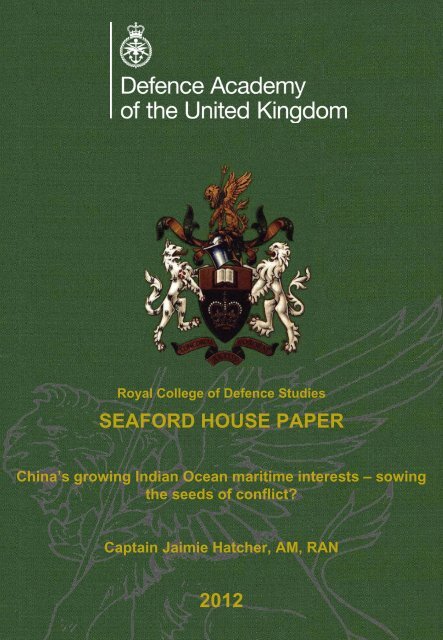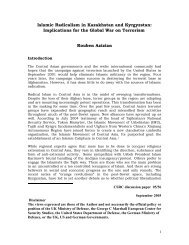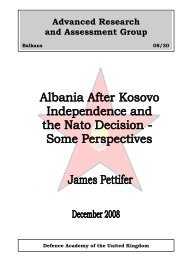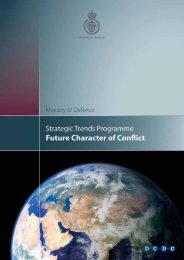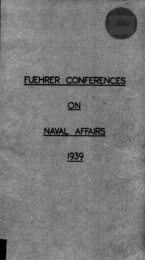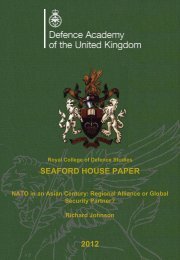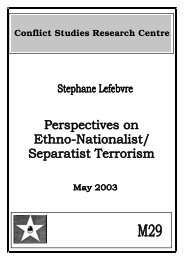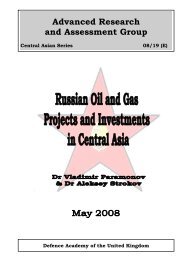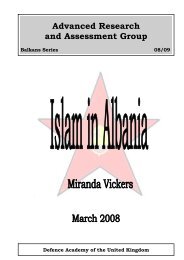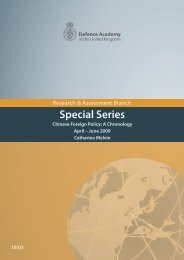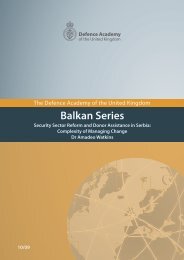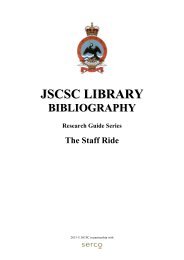to get the file - Defence Academy of the United Kingdom
to get the file - Defence Academy of the United Kingdom
to get the file - Defence Academy of the United Kingdom
Create successful ePaper yourself
Turn your PDF publications into a flip-book with our unique Google optimized e-Paper software.
Royal College <strong>of</strong> <strong>Defence</strong> Studies<br />
SEAFORD HOUSE PAPER<br />
China’s growing Indian Ocean maritime interests – sowing<br />
<strong>the</strong> seeds <strong>of</strong> conflict<br />
Captain Jaimie Hatcher, AM, RAN<br />
2012
CONDITION OF RELEASE<br />
The <strong>United</strong> <strong>Kingdom</strong> Government retains all propriety rights in <strong>the</strong><br />
information contained herein including any patent rights and all<br />
Crown Copyright where <strong>the</strong> author is identified as a Civil Servant<br />
or a member <strong>of</strong> Her Majesty’s Armed Forces. For all o<strong>the</strong>r authors<br />
<strong>the</strong> proprietary rights vest in <strong>the</strong> author or <strong>the</strong>ir employer. No<br />
material or information contained in this publication should be<br />
reproduced, s<strong>to</strong>red in a retrieval system, or transmitted in any form<br />
without <strong>the</strong> prior written consent <strong>of</strong> <strong>the</strong> UK Ministry <strong>of</strong> <strong>Defence</strong>.<br />
The Publication right in <strong>the</strong>se papers vests in <strong>the</strong> Secretary <strong>of</strong><br />
State for <strong>Defence</strong> <strong>of</strong> <strong>the</strong> <strong>United</strong> <strong>Kingdom</strong> <strong>of</strong> Great Britain and<br />
Nor<strong>the</strong>rn Ireland.<br />
Disclaimer<br />
The views expressed in this paper are those <strong>of</strong> <strong>the</strong> Author(s) and<br />
do not necessarily represent those <strong>of</strong> <strong>the</strong> UK Ministry <strong>of</strong> <strong>Defence</strong>,<br />
any o<strong>the</strong>r department <strong>of</strong> Her Britannic Majesty’s Government, or<br />
those <strong>of</strong> <strong>the</strong> Author’s employer, national government or sponsor.<br />
Fur<strong>the</strong>r, such views should not be considered as constituting an<br />
<strong>of</strong>ficial endorsement <strong>of</strong> factual accuracy, opinion, conclusion or<br />
recommendation <strong>of</strong> <strong>the</strong> UK Ministry <strong>of</strong> <strong>Defence</strong>, any o<strong>the</strong>r<br />
department <strong>of</strong> Her Britannic Majesty’s Government, or <strong>of</strong> <strong>the</strong><br />
Author’s employer, national government or sponsor<br />
Majesty’s Government or those <strong>of</strong> <strong>the</strong> Author’s employer, national<br />
government or sponsor.<br />
© Royal Australian Navy, 2012
ROYAL COLLEGE OF DEFENCE STUDIES<br />
China’s growing Indian Ocean maritime<br />
interests – sowing <strong>the</strong> seeds <strong>of</strong> conflict<br />
A DISSERTATION<br />
BY<br />
Captain Jaimie Hatcher, AM, RAN<br />
Royal Australian Navy<br />
July 2012<br />
© Royal Australian Navy 2012
INTENTIONALLY BLANK<br />
1
EXECUTIVE SUMMARY<br />
The rising power <strong>of</strong> China and its growing thirst for energy and resources has reestablished<br />
<strong>the</strong> strategic importance <strong>of</strong> <strong>the</strong> Indian Ocean Region. An examination <strong>of</strong> state<br />
responses <strong>to</strong> Chinese activities in <strong>the</strong> IOR is provided, concluding that concerned states<br />
are responding <strong>to</strong> China’s growing influence with predominantly balancing or containing<br />
strategies. While an uneasy ‘status quo’ may presently exist, China’s emerging political<br />
and social revolution necessary <strong>to</strong> maintain <strong>the</strong> underpinning growth <strong>of</strong> China’s<br />
economy will lead <strong>to</strong> increased conflict in <strong>the</strong> IOR as states compete <strong>to</strong> secure energy and<br />
resources. If China responds <strong>to</strong> domestic challenges by becoming revolutionary and<br />
developing a propensity for strategic risk, <strong>the</strong> his<strong>to</strong>rical likelihood suggests increased<br />
conflict leading <strong>to</strong> war. This paper <strong>the</strong>refore concludes China is sowing <strong>the</strong> seeds <strong>of</strong><br />
conflict in <strong>the</strong> IOR <strong>to</strong> safeguard energy supply. Until China’s rise settles out and <strong>the</strong><br />
balance <strong>of</strong> global order returns, <strong>the</strong> increased risk <strong>of</strong> conflict in <strong>the</strong> IOR presents a<br />
significant international challenge.<br />
2
TABLE OF CONTENTS<br />
EXECUTIVE SUMMARY………………………………………………………………2<br />
TABLE OF CONTENTS………………………………………………………………...3<br />
CHAPTER 1 – INTRODUCTION…………………………………………………….4<br />
Introduction………………………………………………………………………………4<br />
Approach…………………………………………………………………………………5<br />
Scope…………………………………………………………………………………......6<br />
IOR His<strong>to</strong>ry and Geographical Context………………………………………………….6<br />
CHAPTER 2 – THE NATURE OF CHINA’S RISE AND INTEREST<br />
IN THE IOR………………………………………………..…………………………..9<br />
China’s Rise………………………………………………………..……………………9<br />
The Importance <strong>of</strong> Energy <strong>to</strong> China…………………………………………………….10<br />
China – IOR: Relationships and Strategic Intent……………………………………….12<br />
CHAPTER 3 – STATE RESPONSES TO CHINA’S RISE<br />
AND RELATIONSHIPS…………...……….............……………………………...…17<br />
India Relationships and State Response <strong>to</strong> Chinese Rising Power…………..…………20<br />
U.S. Relationships and State Response <strong>to</strong> Chinese Rising Power ….………………….23<br />
Australia Relationships and State Response <strong>to</strong> Chinese Rising Power ..……………….27<br />
Pakistan Relationships and State Response <strong>to</strong> Chinese Rising Power...………………..29<br />
O<strong>the</strong>r IOR states – Sino Relationship and State Response <strong>to</strong> Rising Power….………...32<br />
Predominant Behaviour…………………………………………………………………32<br />
Conclusion……………………………………………………………………………....34<br />
Bibliography…………………………………………………………………….............38<br />
3
CHAPTER 1<br />
INTRODUCTION<br />
“Accelerate its (PLA-N) transformation and modernisation in a sturdy<br />
way, and make extended preparations for warfare in order <strong>to</strong> make<br />
greater contributions <strong>to</strong> safeguard national security.” 1<br />
Hu Jintao, 7 December 2011<br />
Introduction<br />
The rising power <strong>of</strong> China and its growing thirst for energy and resources has reestablished<br />
<strong>the</strong> strategic importance <strong>of</strong> <strong>the</strong> Indian Ocean Region (IOR). This paper will<br />
attempt <strong>to</strong> resolve whe<strong>the</strong>r <strong>the</strong> seeds <strong>of</strong> conflict are being sown in <strong>the</strong> IOR through an<br />
analysis <strong>of</strong> national responses <strong>to</strong>, and <strong>the</strong> nature <strong>of</strong>, China’s national goals and risk<br />
propensity.<br />
Government and defence policy, strategic think tanks and commenta<strong>to</strong>rs pose a<br />
variety <strong>of</strong> views regarding external state behaviour in <strong>the</strong> IOR; particularly that <strong>of</strong> China.<br />
Much <strong>of</strong> <strong>the</strong>ir conjecture centres on whe<strong>the</strong>r China’s actions in this region are strategic or<br />
tactical in nature. Coastal and external states alike are militarising <strong>the</strong> region. A recent<br />
example <strong>of</strong> arguable interpretation, Hu Jintao’s “prepare for war” statement quoted<br />
above, would seemingly conclude that war is inevitable and <strong>the</strong> likely area in which <strong>to</strong><br />
strategically decide such a conflict would be <strong>the</strong> Indian Ocean due <strong>to</strong> its significance in<br />
energy flows and global trade.<br />
Currently, Asian states, notably China, are sharing a larger slice <strong>of</strong> global wealth.<br />
Kaplan proposes this will naturally create aspirations for high tech navies and air forces<br />
capable <strong>of</strong> projecting power and securing access <strong>to</strong> <strong>the</strong> global needs <strong>of</strong> <strong>the</strong>ir nations. 2<br />
1 BBC News China, ‘Hu Jintao Tells China Navy: Prepare for Warfare’,<br />
[http://www.bbc.co.uk/news/world-asia-china-16063607print=true], 7 Dec 11. O<strong>the</strong>r commenta<strong>to</strong>rs<br />
interpreted Hu Jintao differently. They believe his speech was consistent with a more accurate translation<br />
which is make preparations for military struggle, which is argued <strong>to</strong> be a standard formula used in Chinese<br />
military writings and speeches by leaders on military affairs.<br />
2 Robert Kaplan, ‘The 21 st Century’s Defining Battleground is Going <strong>to</strong> be on Water’,<br />
[http://www.eyedrd.org/2011/09/<strong>the</strong>-21st-centurys-defining-battleground-is -going-<strong>to</strong>-be-water.html], 19<br />
Jan 12.<br />
4
Energy security, potentially, is one <strong>of</strong> <strong>the</strong> most significant catalysts for conflict in this<br />
century. 3 Therefore, <strong>the</strong> linkage between maritime power and energy supply naturally<br />
draws strategic planners <strong>to</strong> consider <strong>the</strong> importance <strong>of</strong> <strong>the</strong> IOR. Cordner argues that<br />
maritime security in <strong>the</strong> Indian Ocean is fundamental <strong>to</strong> energy security and, more<br />
broadly, <strong>the</strong> global trading system. 4 Almost every nation <strong>the</strong>refore has an interest in this<br />
issue. Unfortunately, <strong>the</strong> preponderance <strong>of</strong> emotionally charged commentary, varying<br />
degrees <strong>of</strong> strategic ambiguity and associated fear has created strategic unease amongst<br />
interested states.<br />
Approach<br />
Many strategic analysts hold differing views <strong>of</strong> <strong>the</strong> future implications <strong>of</strong> China’s<br />
national goals and how <strong>the</strong>y will be achieved within <strong>the</strong> current world order. There is,<br />
however, a common feature in <strong>the</strong> shape <strong>of</strong> a single, critically important and unanswered<br />
question that will determine <strong>the</strong> way <strong>the</strong> West responds <strong>to</strong> China’s rise: Is Chinese<br />
ambition and action, and <strong>the</strong> national and international policies that give rise <strong>to</strong><br />
<strong>the</strong>m, strategic or tactical in nature Adherence <strong>to</strong> <strong>the</strong> international system is argued<br />
as tactical behaviour if China after gaining sufficient national wealth and power<br />
increasingly acts unilaterally. To behave strategically <strong>the</strong>refore, China will accept an<br />
international rule based system as a permanent condition <strong>of</strong> her foreign policy.<br />
To help answer this question, a case study <strong>of</strong> IOR maritime security will be<br />
examined via a net assessment approach. It is acknowledged that net assessments suffer<br />
several weaknesses. 5 Incorporating a model <strong>of</strong> rising power in this study overcomes <strong>the</strong><br />
challenge <strong>of</strong> assessing numerous strategic relationships and intent. Schweller’s <strong>the</strong>ories<br />
<strong>of</strong> rising great powers provide a reasonable comparative basis as an analytical <strong>to</strong>ol. He<br />
describes a classification system <strong>of</strong> six state responses <strong>to</strong> rising power. The defined<br />
terms used by Schweller are preventive war, balancing/ containment, bandwagoning,<br />
binding, engagement and distance/buckpassing. 6 None is exclusive and it is <strong>of</strong>ten <strong>the</strong><br />
3 Michael Klare, Resource Wars: The New Landscape <strong>of</strong> Global Conflict (New York: Henry Holt and<br />
Company, 2001), p25.<br />
4 Lee Cordner, ‘Maritime Security in <strong>the</strong> Indian Ocean Region: Compelling and Convergent Agendas’,<br />
Australian Journal <strong>of</strong> Maritime and Ocean Affairs, Vol 2(1), 2010, p20.<br />
5 Thomas Skypek, ‘Evaluating Military Balances Through <strong>the</strong> Lens <strong>of</strong> Net Assessment: His<strong>to</strong>ry and<br />
Application’, Journal <strong>of</strong> Military Strategic Studies, Vol 12, Issue 2, 2010, pp9-10.<br />
6 Randall Schweller, ‘Managing <strong>the</strong> Rise <strong>of</strong> Great Powers: His<strong>to</strong>ry and Theory’, in Engaging China: The<br />
Management <strong>of</strong> an Emerging Power, ed by A Johns<strong>to</strong>n and R Ross, (London: Routledge, 1999), pp1-17.<br />
5
case that a state will use a number <strong>of</strong> strategic approaches in its response <strong>to</strong> rising power.<br />
These terms are elaborated in Chapter 3 where several IOR states’ behaviour is examined<br />
<strong>to</strong> determine dominant state response <strong>to</strong> China’s behaviour in <strong>the</strong> IOR. The resultant<br />
typology considering <strong>the</strong> future challenges <strong>to</strong> China and her ensuing national goals and<br />
risk propensity will <strong>of</strong>fer a conclusion as <strong>to</strong> whe<strong>the</strong>r China is sowing <strong>the</strong> seeds <strong>of</strong> conflict<br />
in <strong>the</strong> IOR – acting strategically or tactically.<br />
Scope<br />
Schweller’s model relies on examining <strong>the</strong> behaviour <strong>of</strong> respondent states <strong>to</strong><br />
rising power <strong>to</strong> determine <strong>the</strong> potential for conflict. Due <strong>to</strong> <strong>the</strong> significant number <strong>of</strong><br />
states in <strong>the</strong> IOR, this study will prioritise examination. Nations considered in this study<br />
are: <strong>the</strong> <strong>United</strong> States (U.S.); India, also a rising power with significant interest in <strong>the</strong><br />
region; Pakistan and Australia due <strong>to</strong> <strong>the</strong>ir long term relationship with China and <strong>the</strong> U.S.<br />
O<strong>the</strong>r states such as Sri Lanka, Bangladesh, Myanmar, Seychelles, <strong>the</strong> Maldives,<br />
Malaysia, Indonesia and Singapore will be considered briefly as <strong>the</strong>y contribute <strong>to</strong><br />
understanding state interaction and <strong>the</strong> broader nature <strong>of</strong> China’s national goals. Finally,<br />
as principal providers <strong>of</strong> <strong>the</strong> energy and resource needs <strong>of</strong> <strong>the</strong> rising power, <strong>the</strong> Middle<br />
East and East African regions are included, but will be assessed on a regional basis <strong>to</strong><br />
simplify describing <strong>the</strong> nature <strong>of</strong> individual geo-political relationships.<br />
IOR His<strong>to</strong>ry and Geographical Context<br />
Within <strong>the</strong> IOR, 51 states, coastal and land-locked, provide homes for 2.6 billion<br />
people. The IOR forms a vital part <strong>of</strong> <strong>the</strong> global shipping network and includes <strong>the</strong> key<br />
maritime straits <strong>of</strong> Hormuz, Malacca and Bab el Mandeb. Some 50 percent <strong>of</strong> world<br />
container traffic and 70 percent <strong>of</strong> <strong>the</strong> world’s petroleum products travel across IOR<br />
waters. In 2009, <strong>the</strong>re were 146 ongoing conflicts, <strong>of</strong> which 23 were considered <strong>to</strong> be<br />
high intensity. 7 According <strong>to</strong> <strong>the</strong> Heidelberg Institute for International Conflict Research<br />
(HIIK) Conflict Barometer, <strong>the</strong> IOR is encircled by conflict. States where high intensity<br />
violent conflict existed in 2010 included: Sudan, Somalia, Ethiopia, Yemen, Pakistan,<br />
7 Christian Bouchard, ‘Key Indian Ocean Maritime Security Issues and Challenges’, in Proceedings from<br />
<strong>the</strong> Indian Ocean Maritime Security Symposium, convened by L. Cordner (Australian Centre for Ocean<br />
Resources and Security, University <strong>of</strong> Wollongong, 2009), p6.<br />
6
India, Myanmar and Thailand. 8 Against this background, an increase in piracy tar<strong>get</strong>ing<br />
‘energy vessels’ in <strong>the</strong> Malacca Strait (25 percent <strong>of</strong> attacks) and <strong>of</strong>f <strong>the</strong> coast <strong>of</strong> Somalia<br />
have underscored <strong>the</strong> importance <strong>of</strong> maritime security in <strong>the</strong> IOR. 9 It is not surprising<br />
that external states with growing appetites for energy and trade across <strong>the</strong> IOR seek <strong>to</strong><br />
secure <strong>the</strong> vital sea lanes <strong>of</strong> communication (SLOC), where <strong>the</strong> supply <strong>of</strong> energy and<br />
conduct <strong>of</strong> trade is being threatened.<br />
Until 1700, <strong>the</strong> Indian Ocean hosted <strong>the</strong> world’s largest thriving sea borne trade,<br />
with Muslim, Indian and Chinese traders sailing its waters. A significant his<strong>to</strong>rical<br />
episode occurred in <strong>the</strong> early 1400s, which explains contemporary Chinese philosophy<br />
and its approach <strong>to</strong> <strong>the</strong> IOR. 10 China dispatched seven large Indian Ocean diplomatic<br />
naval expeditions led by <strong>the</strong> legendary Admiral Zhang. He sailed as far as <strong>the</strong> Persian<br />
Gulf, <strong>the</strong> Red Sea and East Africa. Similarly, <strong>the</strong> Ot<strong>to</strong>mans, Persians and Mughals also<br />
developed navies in <strong>the</strong>ir respective regions, which were responsible for protecting <strong>the</strong><br />
east-west trade route across <strong>the</strong> IOR. 11 European dominance followed this period, before<br />
British domination, and <strong>the</strong>n cold war powers assumed control, albeit in competition. As<br />
Indian power also rises so <strong>to</strong>o does her strategic traction in <strong>the</strong> IOR.<br />
In <strong>the</strong> 1970s and 1980s <strong>the</strong> Indian Ocean was regarded as its own strategic entity,<br />
which should not au<strong>to</strong>matically become a prize for super-power conflict. At <strong>the</strong> <strong>United</strong><br />
Nations a proposal <strong>to</strong> adopt an Indian Ocean Peace Zone was tabled and discussed<br />
annually. Beazley claims that at <strong>the</strong> time, <strong>the</strong> relatively low level interest <strong>of</strong> <strong>the</strong> superpowers<br />
meant it had a chance <strong>of</strong> success. 12 Following <strong>the</strong> oil crisis <strong>of</strong> 1973, renewed<br />
focus <strong>of</strong> <strong>the</strong> super-powers in <strong>the</strong> Persian Gulf and Arabian Sea meant that peace zones<br />
became lost in <strong>the</strong> rush <strong>to</strong> secure access <strong>to</strong> energy. Some commenta<strong>to</strong>rs argue that <strong>the</strong><br />
chance for contemporary peace in <strong>the</strong> IOR was lost at this point.<br />
8 Heidelberg Institute for International Conflict Research, Conflict Barometer 2010,<br />
[http://www.hiik.de/en/konfliktbarometer/pdf/ConflictBarometer_2010.pdf], 30 Apr 12.<br />
9 Dennis Rumley, ‘Indian Ocean Maritime Security: Energy Security’, in Proceedings from <strong>the</strong> Indian<br />
Ocean Maritime Security Symposium, convened by L. Cordner (Australian Centre for Ocean Resources<br />
and Security, University <strong>of</strong> Wollongong, 2009), pp12-13.<br />
10 Michael Barr, Who’s Afraid <strong>of</strong> China – The Challenge <strong>of</strong> Chinese S<strong>of</strong>t Power (London and New York:<br />
Zed Books, 2011), pp80-81.<br />
11 Sergei Desilva-Ranasinghe, ‘The Indian Ocean Through <strong>the</strong> Ages’, Journal <strong>of</strong> <strong>the</strong> Australian Naval<br />
Institute, Issue 140, 2011, pp20-25.<br />
12 Quoted in ibid, p17.<br />
7
When <strong>the</strong> cold war concluded, <strong>the</strong> U.S. continued <strong>the</strong>ir naval and military build<br />
up. While distracted by <strong>the</strong> War on Terror and Al Qaeda, however, U.S. strategy did not<br />
consider entirely o<strong>the</strong>r developments in <strong>the</strong> IOR. Over <strong>the</strong> past decade, <strong>the</strong> emerging<br />
powers <strong>of</strong> China and India and <strong>the</strong> declining influence <strong>of</strong> <strong>the</strong> U.S. have again changed <strong>the</strong><br />
nature <strong>of</strong> IOR maritime security. Their growing and almost insatiable demand for energy<br />
and maritime trade across <strong>the</strong> IOR has been central <strong>to</strong> each nation’s interest.<br />
8
CHAPTER 2<br />
THE NATURE OF CHINA’S RISE AND INTEREST IN THE IOR<br />
China’s Rise<br />
Since deep economic reform initiated in 1978, China has surpassed <strong>the</strong> U.S. in<br />
economic performance across an impressive range <strong>of</strong> metrics. China’s net foreign assets<br />
over<strong>to</strong>ok <strong>the</strong> U.S. in 2003. China has net assets <strong>to</strong>day <strong>of</strong> $2.3 trillion compared <strong>to</strong> U.S.<br />
debt <strong>of</strong> $2.5 trillion. Chinese exports surpassed U.S. exports in 2007 and Chinese fixed<br />
capital investment over<strong>to</strong>ok U.S. investment in 2009. Similarly, manufacturing output<br />
and energy consumption exceeded U.S. levels in 2010. It is anticipated that Chinese<br />
imports will be greater than <strong>the</strong> U.S. by 2014. Chinese s<strong>to</strong>ck market capitalisation will be<br />
greater than <strong>the</strong> U.S. by 2020. Chinese defence expenditure will surpass <strong>the</strong> U.S. in<br />
absolute terms by 2025. This tremendous economic revolution is a result <strong>of</strong> 50 years <strong>of</strong><br />
well-considered Chinese statecraft. Ano<strong>the</strong>r revolution, however, may soon engross<br />
China and complicate her rise.<br />
Hu Jintao’s statement <strong>to</strong> <strong>the</strong> annual Chinese National People’s Congress in March<br />
2012, indicates that China is poised <strong>to</strong> begin ano<strong>the</strong>r revolution. Reforming <strong>the</strong> country’s<br />
political system is argued as necessary <strong>to</strong> enable continued economic reform and growth.<br />
This will enable more equitable distribution <strong>of</strong> wealth amongst China’s people, a<br />
transition which will transcend national boundaries and affect <strong>the</strong> international system.<br />
Hu said, “Reform has reached a critical stage. Without <strong>the</strong> success <strong>of</strong> political reform,<br />
economic reforms cannot be carried out. The results that we have achieved may be lost.<br />
A his<strong>to</strong>rical tragedy like <strong>the</strong> Cultural Revolution may occur again.” 13 If forecasts are<br />
correct, China is soon <strong>to</strong> enter ano<strong>the</strong>r revolutionary phase <strong>of</strong> her development, which<br />
will affect international relations. Australia’s former Foreign Affairs Minister, Mr Kevin<br />
Rudd, concluded in a recent speech that <strong>the</strong>re is no evidence <strong>to</strong> support <strong>the</strong> <strong>the</strong>ory <strong>of</strong><br />
China breaking up due <strong>to</strong> social upheaval or <strong>the</strong> collapse <strong>of</strong> <strong>the</strong> Communist Party. 14<br />
13 The Australian, ‘Wen Jiabao's remarkable road <strong>to</strong> reform’,<br />
[http://www.<strong>the</strong>australian.com.au/news/world/wen-jiabaos-remarkable-road-<strong>to</strong>-reform/s<strong>to</strong>ry-fnb1brze-<br />
1226301929918], 21 Mar 12.<br />
14 Kevin Rudd, ‘The Prospects for Peace in <strong>the</strong> Pacific: The Future <strong>of</strong> <strong>the</strong> Expanded East Asia Summit’,<br />
Speech <strong>to</strong> <strong>the</strong> Asia Society, New York, 13 Jan 12.<br />
9
China’s rapidly growing reliance upon energy, though, is a different strategic<br />
vulnerability.<br />
The Importance <strong>of</strong> Energy <strong>to</strong> China<br />
Internal peace is a key determinant <strong>of</strong> China’s international behaviour. Her<br />
emerging social needs rely heavily upon energy <strong>to</strong> underpin necessary growth rates,<br />
which enable <strong>the</strong> success <strong>of</strong> government policies and programmes aimed at improving <strong>the</strong><br />
living standards <strong>of</strong> China’s population. Plans <strong>to</strong> urbanise 400 million people before 2030<br />
will increase energy demand about three and a half times more than if this population<br />
remained in rural areas. A rapidly increasing energy supply is fundamental <strong>to</strong> China’s<br />
future.<br />
Since 2005, numerous academics in China have identified <strong>the</strong> link between<br />
overseas economic interests and a strong power-projecting military. In 1996, China’s<br />
growth and demand for energy led her <strong>to</strong> become a net importer <strong>of</strong> crude oil. Between<br />
1999 and 2009, China’s consumption <strong>of</strong> oil doubled. 15 For China, 80 percent <strong>of</strong> <strong>the</strong>ir<br />
petroleum imports pass through <strong>the</strong> Malacca Strait, which has been referred <strong>to</strong> as <strong>the</strong><br />
‘lifeline’ <strong>of</strong> China’s economic development. 16 As a strategic vulnerability <strong>to</strong> energy<br />
supply, China is diversifying suppliers and developing o<strong>the</strong>r transit routes, including<br />
overland pipelines as an alternate means <strong>of</strong> transporting her energy needs. 17 The figure<br />
below illustrates some <strong>of</strong> <strong>the</strong> infrastructure under development.<br />
15 BP, BP Statistical Review <strong>of</strong> World Energy,<br />
[http://www.bp.com/assets/bp_internet/globalbp/globalbp_uk_english/reports_and_publications/statistical_<br />
energy_review_2011/STAGING/local_assets/pdf/statistical_review_<strong>of</strong>_world_energy_full_report_2011.pd<br />
f] , 13 Feb 12, p9.<br />
16 Daniel Hartnett and Frederic Velluci, ‘Toward a Maritime Security Strategy: An Analysis <strong>of</strong> Chinese<br />
Views Since <strong>the</strong> Early 1990s in The Chinese Navy – Expanding Capabilities, Evolving Roles, ed by<br />
P.Saunders et al (Washing<strong>to</strong>n, National Defense University Press, 2011), p87.<br />
17 Andrew Kennedy, ‘China’s New Energy Security Debate’, Survival, Vol 52, Issue 3, 2010, p139.<br />
10
Source: ‘International Relations in an Emerging Multi Lateral World’,<br />
[http://tamilnation.co/intframe/indian_ocean/index.htm], 20 Mar 12<br />
The link between China’s military and economic interests was made clear in a<br />
2005 Chinese military journal:<br />
“The degree <strong>of</strong> development <strong>of</strong> <strong>the</strong> external-facing economy, regardless if<br />
it is protection <strong>of</strong> maritime passageways, <strong>the</strong> expansion <strong>of</strong> foreign trade,<br />
<strong>the</strong> spreading <strong>of</strong> <strong>the</strong> overseas market, or defending overseas production, all<br />
require having a powerful military force as a guarantee, o<strong>the</strong>rwise China<br />
will be possibly caught being passive.” 18<br />
‘As was true <strong>of</strong> <strong>the</strong> U.S. in <strong>the</strong> late nineteenth and early twentieth centuries, so <strong>to</strong>o<br />
is China’s growing economy bringing expanding military capabilities.’ 19 Friedberg<br />
explains that rising powers will <strong>of</strong>ten challenge <strong>the</strong>ir terri<strong>to</strong>rial boundaries and <strong>the</strong><br />
arrangements <strong>of</strong> international institutions. Through <strong>the</strong> lens <strong>of</strong> a pessimistic realist, he<br />
concludes that <strong>the</strong> disputes occurring from <strong>the</strong> expanding interests <strong>of</strong> a rising power and<br />
18 He Jiacheng, Zou Lao and Lai Zhijun, ‘The International Military Situation and China’s Strategy <strong>of</strong><br />
National <strong>Defence</strong> Economic Development’, Junshi Jingji Yanjiu, No 1, 2005, p12.<br />
19 Aaron Friedberg, ‘The Future <strong>of</strong> <strong>United</strong> States-China Relations, Is Conflict Inevitable’, International<br />
Security,Vol 30, No 2, 2005, p18.<br />
11
those <strong>of</strong> its more established counterparts are seldom resolved peacefully. 20 To test <strong>the</strong><br />
validity <strong>of</strong> this view, at least in terms <strong>of</strong> maritime security in <strong>the</strong> Indian Ocean, it is<br />
necessary <strong>to</strong> describe certain aspects <strong>of</strong> <strong>the</strong> relationships between China and interested<br />
IOR states.<br />
China – IOR: Relationships and Strategic Intent<br />
His<strong>to</strong>rically, China has been a land power. Due <strong>to</strong> her unprecedented growth in<br />
<strong>the</strong> past two decades, she has found herself becoming increasingly reliant upon resources<br />
and markets accessible only via maritime trade routes. Chaudhury submits that ensuring<br />
a continuous supply <strong>of</strong> energy is <strong>the</strong> most important pre-requisite for China in continuing<br />
<strong>to</strong> build an advanced industrialised state. 21 China’s sixth <strong>Defence</strong> White Paper is<br />
illuminating when compared <strong>to</strong> <strong>the</strong> earlier version published in 2004. Providing an<br />
insight in<strong>to</strong> <strong>the</strong> pace <strong>of</strong> strategic change in China’s maritime focus, Beijing decided in<br />
only five years <strong>to</strong> advance <strong>the</strong> requirement for military capabilities from ‘strategic<br />
counter attacks’ (2004) <strong>to</strong> ‘strategic projection operations’ (2009). 22<br />
A popular term used <strong>to</strong> describe Chinese maritime strategy in <strong>the</strong> Indian Ocean,<br />
<strong>the</strong> “String <strong>of</strong> Pearls” analogy, describes in one sense <strong>the</strong> nature <strong>of</strong> maritime expansion. 23<br />
It has built a large part <strong>of</strong> a sea port in Gwadar, Pakistan, and ano<strong>the</strong>r port in Pasni (75<br />
miles east), which will be joined <strong>to</strong> <strong>the</strong> port <strong>of</strong> Gwadar via a highway. A maritime<br />
fuelling station was completed on <strong>the</strong> sou<strong>the</strong>rn coast <strong>of</strong> Sri Lanka and in Hamban<strong>to</strong>ta,<br />
Beijing is providing financial aid <strong>to</strong> build a harbour containing two cargo terminals, a<br />
repair yard and bunkering facilities and an oil tank farm is also underway. An extensive<br />
24 25<br />
naval and commercial port in Chittagong completes ‘<strong>the</strong> string <strong>of</strong> pearls’.<br />
This array <strong>of</strong> infrastructure contributes <strong>to</strong> China’s IOR maritime power<br />
projection potential. It should be noted that <strong>the</strong> port in Hamban<strong>to</strong>ta will not be connected<br />
20 Ibid, p19<br />
21 Dipanjan Roy Chaudhury, China - Boosting Maritime Capabilities in <strong>the</strong> Indian Ocean,<br />
[http://www.worldpress.org/Asia/2908.cfm], 18 Nov 11.<br />
22 Sanjay Kumar, China’s Naval Strategy – Implications for India,<br />
[http://www.ipcs.org/article_details.phparticleNo=2823], 28 Oct 11.<br />
23 Y.J. Sithara N. Fernando, ‘China’s Maritime Relations with South Asia: From Confrontation <strong>to</strong> Cooperation<br />
(Part 2)’, Future Directions International, Perth, 2010, p3. A term first used by a US consulting<br />
company in 2005.<br />
24 Robert Kaplan, ‘Center Stage for <strong>the</strong> Twenty-first Century’, Foreign Affairs,Vol 88, Issue 2, 2009, p19.<br />
25 Gurpreet Khurana, ‘China’s String <strong>of</strong> Pearls in <strong>the</strong> Indian Ocean and Its Security Implications’, Strategic<br />
Analysis, Vol 32, No 1, 2008, p8.<br />
12
<strong>to</strong> China via a pipeline. Therefore, its purpose seems more likely <strong>to</strong> support <strong>the</strong><br />
capability <strong>of</strong> a physical naval presence than contribute <strong>to</strong> security <strong>of</strong> energy supply. The<br />
o<strong>the</strong>rs, by virtue <strong>of</strong> land-based pipelines, rail and road connections <strong>to</strong> mainland China<br />
contribute <strong>to</strong> <strong>the</strong> strategy <strong>of</strong> diversifying <strong>the</strong> routes for energy and resource supply from<br />
<strong>the</strong> Middle East and Africa, avoiding <strong>the</strong> Malacca Strait in particular and could be argued<br />
as less confrontational.<br />
Since <strong>the</strong> early 1990s, China has taken <strong>the</strong> opportunity <strong>to</strong> assist Myanmar both<br />
financially and technically for <strong>the</strong> construction <strong>of</strong> new military facilities and upgrades <strong>of</strong><br />
existing ones. It follows that although <strong>the</strong>re is no evidence <strong>of</strong> a permanent military<br />
presence, China will very likely enjoy and undertake periodic visits <strong>to</strong> access and become<br />
familiar with <strong>the</strong>se facilities. Publicly, it is stated that <strong>the</strong>se activities are <strong>to</strong> improve<br />
trade connectivity. 26 As a logistic supply route for Chinese naval forces operating in <strong>the</strong><br />
Indian Ocean, however, it will obviously form part <strong>of</strong> any strategic calculus.<br />
In 2003, ties with Malaysia were improving and, in 2005, Malaysia became<br />
China’s fourth largest trading partner. To reflect <strong>the</strong> nature <strong>of</strong> this relationship and in<br />
recognition <strong>of</strong> <strong>the</strong> importance <strong>of</strong> <strong>the</strong> Malacca Strait, both countries signed a<br />
Memorandum <strong>of</strong> Understanding on <strong>Defence</strong> Co-operation in September <strong>of</strong> 2005. 27 The<br />
Memorandum provided for military training, exchange <strong>of</strong> personnel and commitment <strong>to</strong><br />
regular dialogue regarding <strong>the</strong>ir security relationship. Since <strong>the</strong> terms <strong>of</strong> trade swung in<br />
China’s favour, <strong>the</strong> relationship has not flourished as anticipated. Consequently, it seems<br />
prudent that Malaysia maintained closer security ties with U.S. and Five Power <strong>Defence</strong><br />
Arrangement authorities. Although <strong>the</strong> relationship with China remains healthy, S<strong>to</strong>rey<br />
points out that it is most likely a Malaysian hedging strategy. 28 The implications for<br />
enhanced security cooperation in <strong>the</strong> maritime management <strong>of</strong> <strong>the</strong> Malacca Strait are as a<br />
result less clear. Indonesia and Thailand have had similar experiences and have behaved<br />
like Malaysia, using <strong>the</strong> U.S. as a security guaran<strong>to</strong>r.<br />
China and <strong>the</strong> Maldives celebrated 40 years <strong>of</strong> formal links this year. An<br />
enduring strategic debate is whe<strong>the</strong>r China will be able <strong>to</strong> establish a base suitable for<br />
26 Ibid, p13.<br />
27 Gurpreet Khurana, ‘China-India Maritime Rivalry’, Indian <strong>Defence</strong> Review, Vol 23, 2008, p90.<br />
28 Ian S<strong>to</strong>rey, Malaysia’s Hedging Strategy With China,<br />
[http://www.james<strong>to</strong>wn.org/single/no_cache=1&tx_ttnews%5Btt_news%5D=4298], 16 Feb 12.<br />
13
supporting submarine operations in Marao. 29 Views range from <strong>the</strong> establishment <strong>of</strong> a<br />
base being unlikely owing <strong>to</strong> <strong>the</strong> close and more influential relationship between India<br />
and <strong>the</strong> Maldives <strong>to</strong> being a virtual fait accompli according <strong>to</strong> Pakistani <strong>Defence</strong><br />
reporting. 30 The associated strategic ambiguity only adds <strong>to</strong> mounting concern in <strong>the</strong><br />
region.<br />
Although <strong>the</strong> existence or intent <strong>of</strong> <strong>the</strong> base in <strong>the</strong> Maldives is uncertain and<br />
presumed unlikely, a public announcement by <strong>the</strong> Chinese Government in December<br />
2011 declared <strong>the</strong> Seychelles had given approval for China <strong>to</strong> set up a military base on<br />
<strong>the</strong> archipelago <strong>to</strong> help fight piracy in <strong>the</strong> Indian Ocean. 31 Some commenta<strong>to</strong>rs link a<br />
visit by Hu Jintao <strong>to</strong> <strong>the</strong> Seychelles in 2007 as one not based on economic development<br />
but <strong>to</strong> propose future maritime security capabilities. In a recent announcement<br />
dampening regional concern, Seychelles’ Foreign Affairs Minister, Jean Paul Adam<br />
clarified that Vic<strong>to</strong>ria is looking ra<strong>the</strong>r at having ‘reconnaissance planes and patrol ships<br />
stationed <strong>the</strong>re’. 32 Such a base, however, would enable o<strong>the</strong>r maritime operations <strong>to</strong> be<br />
supported in <strong>the</strong> IOR. Whe<strong>the</strong>r <strong>the</strong> Maldives option materialises or not, what is clear is<br />
that attempts <strong>to</strong> secure such capabilities in <strong>the</strong> IOR add <strong>to</strong> growing militarisation <strong>of</strong> <strong>the</strong><br />
region.<br />
There has been a concomitant rise in China’s military presence in <strong>the</strong> IOR causing<br />
anxiety in <strong>the</strong> minds <strong>of</strong> regional governments about her strategic intent. Some<br />
explanation comes with analysis <strong>of</strong> China’s National Defense 2010 White Paper, where it<br />
states ‘<strong>the</strong> PLA(N) enhances <strong>the</strong> construction <strong>of</strong> composite support bases so as <strong>to</strong> build a<br />
shore-based support system, which matches <strong>the</strong> deployment <strong>of</strong> forces’. 33 It is <strong>the</strong>refore<br />
highly likely that China would exploit <strong>the</strong> potential <strong>of</strong> <strong>the</strong>se prospective naval bases in<br />
<strong>the</strong> IOR in line with her ‘strategic projection operations’ policy if conflict or risk <strong>to</strong><br />
energy supply emerged. 34<br />
29 Nathaniel Barber et al, ‘China in <strong>the</strong> Indian Ocean: Impacts, Prospects, Opportunities’ (University <strong>of</strong><br />
Wisconsin: La Follette School <strong>of</strong> Public Affairs, 2011) p9.<br />
30 Pakistan <strong>Defence</strong>, [http://www.defence.pk/forums/strategic-geopolitical-issues/8165-china-acquiresbase-maldives-against-india-some-help-pakistan.html],<br />
16 Feb 11.<br />
31 MaritimeSecurity.Asia, [http://maritimesecurity.asia/free-2/sea-lines-<strong>of</strong>-communication/china-beefingup-military-presence-in-indian-ocean-6],<br />
19 Jan 12<br />
32 Idem.<br />
33 Information Office <strong>of</strong> China’s State Council, ‘China’s National Defense in 2010’, Beijing, 2011.<br />
34 Idem.<br />
14
China continues <strong>to</strong> secure new energy markets fur<strong>the</strong>r afield in <strong>the</strong> Middle East<br />
and East Africa in competition with <strong>the</strong> U.S. and o<strong>the</strong>rs. These emerging relationships<br />
are driven principally by economic needs and are not necessarily state orchestrated. 35<br />
Commercial relationships seeking <strong>to</strong> deliver energy and o<strong>the</strong>r necessary resources <strong>to</strong><br />
China’s growing economy remain a significant state interest. In <strong>the</strong> Middle East, trade<br />
between China and <strong>the</strong> region has doubled since 2000 and is forecast <strong>to</strong> quadruple in <strong>the</strong><br />
next two decades. 36 China is Tehran’s biggest oil and gas cus<strong>to</strong>mer. 37 The majority <strong>of</strong><br />
trade exported from Africa <strong>to</strong> China is oil, second only <strong>to</strong> <strong>the</strong> Middle East. Sudan is a<br />
significant oil exporter <strong>to</strong> China, with o<strong>the</strong>rs mainly in West Africa. Alden asserts that<br />
China’s principal motivation for her interest in Africa is resource acquisition and business<br />
opportunitism. 38 The various oil deals are usually characterised by loans and credit lines<br />
in connection with infrastructure projects <strong>to</strong> benefit agreed African regions. 39<br />
In contrast <strong>to</strong> China’s deepening relationships, <strong>the</strong> US currently suffers from<br />
declining relations with several Middle Eastern countries. The decline is attributed <strong>to</strong><br />
interventions in Iraq and Afghanistan and ongoing nuclear weapon disputes with Iran,<br />
which in turn has led <strong>to</strong> Middle Eastern countries seeking <strong>to</strong> gain Chinese support in<br />
regional disputes. According <strong>to</strong> Chen, relations with China are seen somewhat like a<br />
badge, perhaps <strong>to</strong> establish a greater measure <strong>of</strong> independence from U.S. influence. 40<br />
As Chinese politics rubs up against <strong>the</strong> U.S. in <strong>the</strong> Middle East, and U.S. foreign<br />
policy suffers from <strong>the</strong> blemishes <strong>of</strong> Iraq and Afghanistan, <strong>the</strong> advantage lies with China.<br />
In fact, due <strong>to</strong> <strong>the</strong> importance <strong>of</strong> energy supply, <strong>the</strong> contrasting nature <strong>of</strong> economic and<br />
military relationships between China, Iran and Pakistan will create formidable policy<br />
challenges confronting U.S. ability <strong>to</strong> assure maritime security <strong>of</strong> <strong>the</strong> IOR. In sustaining<br />
global leadership and defence, <strong>the</strong> U.S. acknowledges China’s and Iran’s pursuit <strong>of</strong><br />
asymmetric means <strong>to</strong> counter power projection capabilities. 41 The use <strong>of</strong> asymmetric<br />
anti-access measures will remain a potent challenge. China is evidently aware <strong>of</strong> <strong>the</strong><br />
35 Chris<strong>to</strong>pher Alessi and Stephanie Hanson, ‘Expanding China-Africa Oil Ties’, Council on Foreign<br />
Relations, [http://www.cfr.org/china/expanding-china-africa-oil-ties/p9557], 16 Feb 12.<br />
36 Mohan Malik, ‘China and India – Great Power Rivals’, (London: First Forum Press, 2011), p327.<br />
37 Berlin, op cit, p62.<br />
38 Chris Alden, ‘China in Africa’, (London: Zed Books Limited, 2007), p8.<br />
39 Alessi and Hanson, op cit.<br />
40 James Chen, ‘The Emergence <strong>of</strong> China in <strong>the</strong> Middle East’, Strategic Forum, Institute for National<br />
Strategic Studies, NDU, No 271, 2011, p6.<br />
41 U.S. Government, ‘A Co-operative Strategy for 21 st Century Seapower’,<br />
[http://www.navy.mil/maritime/Maritimestrategy.pdf], 1 Feb 12, p4.<br />
15
suspicion created by her overall actions in <strong>the</strong> Indian Ocean, and more generally in East<br />
Asia. Undaunted, China sets an objective <strong>to</strong> complete mechanization (high tech military<br />
forces) and attaining major progress in informatisation (joint networked forces) by 2020<br />
as a right <strong>of</strong> state. 42 It seems a large basis <strong>of</strong> <strong>the</strong>se objectives is <strong>to</strong> be able <strong>to</strong> project joint<br />
warfare capabilities in<strong>to</strong> <strong>the</strong> IOR, in addition <strong>to</strong> East Asia. The growing ability and<br />
willingness <strong>to</strong> project force is a sign <strong>of</strong> China’s deterrent <strong>to</strong> o<strong>the</strong>rs and also as a sign <strong>of</strong><br />
future capability <strong>to</strong> protect her sovereign interests. Of course this precipitates response<br />
from o<strong>the</strong>r states.<br />
42 Information Office <strong>of</strong> China’s State Council, ‘China’s National Defense in 2010, Beijing, 2011.<br />
16
CHAPTER 3<br />
STATE RESPONSES TO CHINA’S RISE AND RELATIONSHIPS<br />
Identified in Chapter 1, Schweller defined six ways <strong>to</strong> describe <strong>the</strong> nature <strong>of</strong> state<br />
response <strong>to</strong> rising power. From <strong>the</strong> perspective <strong>of</strong> o<strong>the</strong>r states, this chapter aims <strong>to</strong> define<br />
<strong>the</strong> nature <strong>of</strong> each relationship with China, using Schweller’s model. The classification<br />
system is described in <strong>the</strong> table below. Although numerous IOR states have a stake and<br />
interest in IOR maritime security, most <strong>of</strong> this part will focus upon relations with and<br />
between China, <strong>the</strong> U.S., India, Australia and Pakistan. However, it is important <strong>to</strong><br />
understand <strong>the</strong> broader context and o<strong>the</strong>r IOR state relationships, especially where <strong>the</strong>re<br />
is competition for <strong>the</strong>ir allegiance, are included.<br />
STATE RESPONSE<br />
DESCRIPTION<br />
POLICY OPTIONS<br />
Preventive War This sort <strong>of</strong> conflict is unique, as it is always a<br />
gamble. Is it better <strong>to</strong> force war now, hoping for a<br />
limited conflict compared <strong>to</strong> what potentially may lie<br />
ahead when greater and more costly war may<br />
transpire, or is it better <strong>to</strong> persist with o<strong>the</strong>r means <strong>to</strong><br />
resolve a long term threat. 43 Preventive wars though<br />
have rarely been waged <strong>to</strong> mitigate strategic or<br />
economic vulnerability.<br />
Balancing/Containment The concept <strong>of</strong> balancing or containment means <strong>to</strong><br />
oppose <strong>the</strong> stronger or more threatening side in a<br />
conflict. This is achieved in two ways. First,<br />
internal balancing, where individual attempts are<br />
made <strong>to</strong> mobilise national power <strong>to</strong> match those <strong>of</strong><br />
<strong>the</strong> enemy. Second, external balancing, where <strong>the</strong><br />
establishment <strong>of</strong> formal or informal alliances is<br />
directed against <strong>the</strong> rising state. 44<br />
43 Schweller, op cit, pp8-9.<br />
44 Ibid, pp9-10.<br />
17
Bandwagoning Bandwagoning, as <strong>the</strong> terms suggests, means <strong>to</strong> join a<br />
stronger coalition, <strong>the</strong> opposite approach <strong>to</strong><br />
Balancing. 45 Wright explains that in some<br />
circumstances, great powers engage in bandwagoning<br />
where <strong>the</strong>y are in fact balancing because <strong>the</strong>y ally<br />
with a weaker side <strong>to</strong> hold a more powerful enemy in<br />
check. 46<br />
Binding<br />
Schweller describes binding as <strong>the</strong> strategy a state<br />
employs when it seeks <strong>to</strong> ally with <strong>the</strong> source <strong>of</strong> <strong>the</strong><br />
threat, hoping it will be able <strong>to</strong> exert some measure <strong>of</strong><br />
control over its policy. 47 This approach can be<br />
fur<strong>the</strong>r expanded when appropriate multilateral<br />
alliances or collective security arrangements are used<br />
<strong>to</strong> complement bilateral binding ambitions.<br />
Engagement<br />
Engagement is <strong>the</strong> use <strong>of</strong> non-coercive means where<br />
<strong>the</strong> goal is <strong>to</strong> ensure that rising power is used in ways<br />
that are consistent with peaceful change according <strong>to</strong><br />
developing regional and global orders. Appeasement<br />
is cited as <strong>the</strong> most common form <strong>of</strong> engagement,<br />
which in international political terms is <strong>the</strong> use <strong>of</strong><br />
rational negotiation and compromise <strong>to</strong> avoid armed<br />
conflict as a way <strong>of</strong> resolving disputes. 48<br />
Buckpassing/Distance Buckpassing occurs according <strong>to</strong> Schweller when “a<br />
state attempts <strong>to</strong> ride free on <strong>the</strong> balancing efforts <strong>of</strong><br />
o<strong>the</strong>rs.” 49 Buckpassing normally occurs when wars<br />
<strong>of</strong> attrition are likely and <strong>the</strong> state would be<br />
disadvantaged if <strong>the</strong> rising power defeated <strong>the</strong><br />
coalition against it only <strong>to</strong> be confronted by an even<br />
stronger rising power. Similarly, ‘distance’ occurs<br />
when a state accepts that <strong>the</strong> combined strength <strong>of</strong> <strong>the</strong><br />
coalition is unlikely <strong>to</strong> deter or defeat <strong>the</strong> rising<br />
45 Ibid, pp10-12.<br />
46 Quincy Wright, ‘A Study <strong>of</strong> War’, (Chicago, University <strong>of</strong> Chicago Press, 1964), p136.<br />
47 Schweller, op cit, p13.<br />
48 Ibid, p14-16.<br />
49 Ibid, pp16-17.<br />
18
power and, not being threatened immediately, seeks<br />
<strong>to</strong> continue <strong>to</strong> engage with <strong>the</strong> aggressive power.<br />
The U.S., India and China are engaged in what might be described as strategic<br />
preparation <strong>of</strong> <strong>the</strong> IOR battlespace. India’s successful test firing <strong>of</strong> her first intercontinental<br />
ballistic missile is an example <strong>of</strong> escalating deterrence. 50 All are similarly<br />
pursuing multi-lateral and bilateral relationships, commercial energy contracts and<br />
military engagement <strong>to</strong> secure <strong>the</strong> key geography <strong>of</strong> <strong>the</strong> Indian Ocean. The U.S.<br />
competition with China is manifesting in a declared alliance and commitment for <strong>the</strong><br />
development <strong>of</strong> a ‘special relationship’ with India, a clear counter strategy <strong>to</strong> China’s<br />
emergent influence in <strong>the</strong> IOR. Australia and Pakistan are both developing <strong>the</strong>ir<br />
militaries over <strong>the</strong> next decade or so in<strong>to</strong> more muscular capabilities and are agreeing <strong>to</strong><br />
allies’ use <strong>of</strong> <strong>the</strong>ir terri<strong>to</strong>ry, which in <strong>the</strong> event <strong>of</strong> conflict in <strong>the</strong> IOR will be strategically<br />
vital. The figure below illustrates <strong>the</strong> emerging militarisation <strong>of</strong> <strong>the</strong> IOR.<br />
Source: International Maritime Bureau, ‘The Battle for <strong>the</strong> Indian Ocean’,<br />
May 2009<br />
50 Times <strong>of</strong> India, ‘Agni-V, India's first ICBM test-fired successfully’,<br />
[http://articles.times<strong>of</strong>india.indiatimes.com/2012-04-19/india/31367147_1_agni-v-mirv-payload-tar<strong>get</strong>ablere-entry-vehicles],<br />
30 Apr 12.<br />
19
India – Relationships and State Response <strong>to</strong> Chinese Rising Power<br />
China and India are regarded as <strong>the</strong> world’s two significant rising powers. Both<br />
have <strong>the</strong>ir share <strong>of</strong> domestic political pressure, where <strong>the</strong>re is a wide gap between<br />
wealthy and impoverished peoples and both states have rapidly rising appetites for<br />
energy. The nature <strong>of</strong> <strong>the</strong>ir relationship with respect <strong>to</strong> IOR maritime security interests is<br />
mixed. Of <strong>the</strong> six behaviours identified by Schweller, <strong>the</strong> relationship between China<br />
and India is predominantly binding, balancing/containment and bandwagoning. These<br />
behaviours reinforce <strong>the</strong> general view that India and China are competing. The<br />
opportunities for engagement are evidently limited as India seems <strong>to</strong> have adopted a view<br />
that appeasing China will simply fur<strong>the</strong>r Chinese relative gains. Notwithstanding, China<br />
principally regards her power competition <strong>to</strong> be with <strong>the</strong> U.S., and is more interested in<br />
securing Chinese interests in <strong>the</strong> IOR based upon harmonious relations with India, <strong>the</strong><br />
arguable regional power.<br />
Binding. Within India, <strong>the</strong>re is strong national consensus on improving and<br />
developing relations with China and agreement that a shortage <strong>of</strong> oil supplies in <strong>the</strong><br />
51 52<br />
future could lead <strong>to</strong> conflicts. As <strong>the</strong> world’s fourth largest energy consumer, India<br />
imports 73 percent <strong>of</strong> its required crude oil, growing <strong>to</strong> 92 percent in 2020. Saudi Arabia<br />
and Nigeria are India’s two largest suppliers <strong>of</strong> oil, with Iran <strong>the</strong> third. Nearly 90 percent<br />
<strong>of</strong> its oil comes from <strong>the</strong> Persian Gulf. India maintains a policy <strong>of</strong> s<strong>to</strong>cking strategic<br />
reserves <strong>of</strong> oil and, as stated in India’s Maritime Military Strategy, <strong>to</strong> ‘overcome<br />
shortages and provide a buffer during crisis/conflicts’. 53 On this basis, Malik amongst<br />
o<strong>the</strong>rs concludes that energy security is what drives India’s foreign policy, similarly <strong>to</strong><br />
China. 54 There was recent Sino-Indian agreement on a bilateral forum <strong>to</strong> establish<br />
dialogue on maritime security in <strong>the</strong> IOR. 55 The proposal was made by China during a<br />
meeting between external affairs ministers. Future maritime security <strong>of</strong> <strong>the</strong> IOR will<br />
hinge on productive outcomes <strong>of</strong> this forum. In <strong>the</strong> context <strong>of</strong> <strong>the</strong> Himalayan border<br />
dispute between China and India, <strong>the</strong> Chinese delegation head, State Councillor Dai<br />
51 Indian Ministry <strong>of</strong> <strong>Defence</strong>, ‘Freedom <strong>to</strong> Use <strong>the</strong> Seas: India’s Maritime Military Strategy’, Integrated<br />
Headquarters MOD (Navy), 2007, p29.<br />
52 Ibid, p46.<br />
53 Ibid, p50.<br />
54 Mohan, Malik, ‘China and India – Great Power Rivals’, (London: First Forum Press, 2011), p338.<br />
55 The Economic Times, ‘Bridging Trust-deficit: India and China agree <strong>to</strong> have maritime dialogue’,<br />
[http://articles.economictimes.indiatimes.com/2012-03-02/news/31116908_1_india-and-china-bilateraltrade-chinese-counterpart-yang-jiechi],<br />
1 Apr 12.<br />
20
Bing-guo, stated that <strong>the</strong> two countries must put aside <strong>the</strong>ir differences and seize ‘a<br />
golden period <strong>to</strong> grow China-India relations’. 56<br />
Notwithstanding <strong>the</strong>se various efforts at binding, New Delhi remains wary <strong>of</strong><br />
growing Chinese influence in <strong>the</strong> Indian Ocean. Geopolitical rivalry between China and<br />
India in <strong>the</strong> Indian Ocean involving competition for influence in numerous countries<br />
features. Significant effort is being made by India <strong>to</strong> re-establish <strong>the</strong> Indian preference<br />
over China <strong>of</strong> key regional neighbours. To highlight <strong>the</strong> perception India is not keeping<br />
up and needs <strong>to</strong> work harder, several strategic commenta<strong>to</strong>rs have produced “energising”<br />
articles about China’s “threatening” activities in <strong>the</strong> IOR, urging <strong>the</strong> Indian Government<br />
<strong>to</strong> cut through its immense bureaucracy, <strong>to</strong> establish closer relations with China’s<br />
maritime neighbours and rapidly develop maritime capabilities <strong>to</strong> protect Indian national<br />
57 58<br />
interests in <strong>the</strong> IOR. There was modest success when China launched <strong>the</strong> Kunming<br />
initiative aimed at developing <strong>the</strong> Mekong delta region, quickly followed by India<br />
declaring <strong>the</strong> Mekong Ganges Cooperation (MGC) project in 2000. India had included<br />
her north eastern provinces and <strong>the</strong> states <strong>of</strong> Myanmar, Thailand, Laos, Cambodia and<br />
Vietnam, but excluded China. The only material change was that India replaced China as<br />
<strong>the</strong> head <strong>of</strong> <strong>the</strong> project. 59<br />
O<strong>the</strong>r Indian behaviour that upsets China stems from initiatives <strong>of</strong> India’s Look<br />
East Policy. Greater co-operation with <strong>the</strong> South East Asian states <strong>of</strong> Malaysia,<br />
Indonesia and Singapore appear <strong>to</strong> consolidate India’s interest in East Asia. The South<br />
Asia Analysis Group identifies that India ‘is reaching out <strong>to</strong> <strong>the</strong> maritime neighbours <strong>of</strong><br />
China by engaging <strong>the</strong> maritime forces <strong>of</strong> <strong>the</strong> countries being visited at regular<br />
intervals’. 60 Establishing an Indo-ASEAN Free Trade Agreement (FTA) in 2010, <strong>the</strong><br />
same year incidentally China signed <strong>the</strong> Sino-ASEAN FTA, adds <strong>to</strong> <strong>the</strong> rivalry. China is<br />
not encouraging India’s growing interest in what Beijing views as her terri<strong>to</strong>ry. Of<br />
particular sensitivity is maritime relations with coastal states <strong>of</strong> <strong>the</strong> South China Sea and<br />
56 BBC News, ‘India and China <strong>to</strong> Begin Border Talks’, [http://www.bbc.co.uk/news/world-asia-china-<br />
160571298print=true], 16 Jan 12.<br />
57 Harsh Pant, ‘China’s Naval Expansion in <strong>the</strong> Indian Ocean and India-China Rivalry’,<br />
[http://japanfocus.org/-Harsh_V_-Pant/3353], 16 Nov 11.<br />
58 R.S. Vasan, ‘China’s Maritime Ambitions: Implications for Regional Security’, South Asia Analysis<br />
Group, Paper No 4281, 17 Jan 11, p4.<br />
59 Malik, op cit, p312.<br />
60 Vasan, op cit, p8.<br />
21
where China’s future control <strong>of</strong> <strong>the</strong> Malacca Strait is at stake. 61<br />
clearly engaged in strategic balancing and containment, and less so binding.<br />
Both states are <strong>the</strong>refore<br />
Balancing/Containment. India has accorded <strong>the</strong> highest priority <strong>to</strong> closer<br />
political, economic and military ties with its IOR neighbours. In response <strong>to</strong> Chinese<br />
maritime related activities in <strong>the</strong> IOR, India has streng<strong>the</strong>ned its military presence in <strong>the</strong><br />
Andaman and Nicobar Island archipelago, as part <strong>of</strong> plans <strong>to</strong> protect its interests.<br />
Establishment <strong>of</strong> <strong>the</strong> integrated Andaman and Nicobar Command (ANC) at Port Blair in<br />
2001 caused concern in Beijing. Already sensitive <strong>to</strong> <strong>the</strong> volume <strong>of</strong> critical maritime<br />
trade and energy resource bound for China passing through <strong>the</strong> Malacca Strait, Beijing<br />
perceives ANC activities <strong>to</strong> serve an opportunity <strong>to</strong> later restrict Chinese activities in <strong>the</strong><br />
area. 62 Future Indian defence capability development plans reinforce <strong>the</strong> perception.<br />
India has also <strong>of</strong>fered <strong>to</strong> develop several ports in <strong>the</strong> IOR in response <strong>to</strong> Chinese<br />
initiatives. The Indian Government <strong>of</strong>fered <strong>to</strong> develop <strong>the</strong> Myanmar ports <strong>of</strong> Dawei and<br />
Sittwe, a potential response <strong>to</strong> China’s naval jetty project in Great Coco Island,<br />
Myanmar. Ano<strong>the</strong>r, was an <strong>of</strong>fer <strong>to</strong> conduct hydrographic surveys for <strong>the</strong> Maldives in<br />
2006, arguably responding <strong>to</strong> extensive Chinese hydrographic survey activities in 2004. 63<br />
India also behaves similarly <strong>to</strong> China in securing long term contracts with energy<br />
supplying states in <strong>the</strong> Persian Gulf. Akin <strong>to</strong> emerging Sino-Middle East relations, an<br />
Indian/Iran LNG supply deal for <strong>the</strong> next 25 years, commencing in 2009, is a case in<br />
point. India is also helping Iran develop <strong>the</strong> port <strong>of</strong> Chah Bahar in <strong>the</strong> Straits <strong>of</strong> Hormuz.<br />
This strait is arguably <strong>the</strong> world’s most important and sensitive maritime choke point. In<br />
summary, <strong>the</strong>se Indian initiatives serve a balancing/containment purpose. Adding <strong>to</strong> <strong>the</strong><br />
balancing evidence is <strong>the</strong> developing relationship between India and <strong>the</strong> U.S. as a<br />
bandwagoning response.<br />
Bandwagoning. In a speech given by US Secretary <strong>of</strong> State, Hillary Clin<strong>to</strong>n,<br />
during a five-day visit <strong>to</strong> India in 2011, U.S. support for India’s activities was<br />
underscored. She said, ‘…India’s leadership will help <strong>to</strong> shape <strong>the</strong> strategic future <strong>of</strong> <strong>the</strong><br />
61 Robert Blackwill et al, ‘The <strong>United</strong> States and India: A Shared Strategic Future’, Joint Study Group<br />
Report, Aspen Institute India, 16 Sep 11, p23.<br />
62 Gurpreet Khurana, ‘China-India Maritime Rivalry’,<br />
[http://www.japantimes.co.jp/text/eo20120103a1.html], 18 Nov 11.<br />
63 Gurpreet Khurana, ‘China’s “String <strong>of</strong> Pearls” in <strong>the</strong> Indian Ocean and its Security Implications’,<br />
Strategic Analysis, Vol 32, No 1, 2008, pp13-14.<br />
22
Asia-Pacific. That’s why <strong>the</strong> U.S. supports India’s Look East policy, and we encourage<br />
India not just <strong>to</strong> look East, but <strong>to</strong> engage East and act East as well…’. 64 It is more likely<br />
that Secretary Clin<strong>to</strong>n’s comments while encouraging India were directed at China,<br />
which has a habit <strong>of</strong> complaining when Indian-led multi-lateral initiatives materialise.<br />
<strong>United</strong> States <strong>of</strong> America – Sino Relationship and State Response <strong>to</strong> Rising Power<br />
As <strong>the</strong> global super power, <strong>the</strong> U.S. understands very well <strong>the</strong> importance <strong>of</strong> seaborne<br />
trade and <strong>the</strong> strategic value in controlling or being able <strong>to</strong> control economic SLOC<br />
and maritime choke points. America thus observes and appreciates <strong>the</strong> overlapping<br />
notion <strong>of</strong> China’s ‘String <strong>of</strong> Pearls’ and India’s fear <strong>of</strong> Chinese encirclement. The<br />
predominance <strong>of</strong> <strong>the</strong> U.S. in <strong>the</strong> Indian Ocean is <strong>the</strong>refore important as an arguably<br />
necessary additional balance <strong>to</strong> China’s evolving presence. As <strong>the</strong> leading global power<br />
albeit declining, <strong>the</strong> predominance <strong>of</strong> <strong>the</strong> U.S. response <strong>to</strong> China is <strong>to</strong> engage,<br />
balance/contain, and bandwagon.<br />
Engagement. Admission <strong>of</strong> China <strong>to</strong> <strong>the</strong> World Trade Organisation is viewed as<br />
an appeasement strategy by some commenta<strong>to</strong>rs. While this may be so, ano<strong>the</strong>r school <strong>of</strong><br />
thought is that it enables <strong>the</strong> U.S. and <strong>to</strong> a lesser extent o<strong>the</strong>rs like <strong>the</strong> E.U., <strong>to</strong> place<br />
institutional controls upon China. A recent example was <strong>the</strong> calling <strong>of</strong> China <strong>to</strong> account<br />
regarding her restrictions upon rare Earth metal exports, which inflates <strong>the</strong> commodity<br />
price <strong>to</strong> <strong>the</strong> cost <strong>of</strong> o<strong>the</strong>r states. 65 This follows ano<strong>the</strong>r similar case found in favour <strong>of</strong><br />
<strong>the</strong> E.U., where China was illegally restricting exports <strong>of</strong> o<strong>the</strong>r materials, such as bauxite,<br />
zinc and magnesium. China is yet <strong>to</strong> fully comply with WTO trading rules. 66 As <strong>the</strong><br />
economic world order changes as forecast in Chapter two, tensions <strong>of</strong> this nature will<br />
continue. In response, <strong>the</strong> U.S. is adjusting her global military force disposition.<br />
A plan conceived by Garrett under discussion in <strong>the</strong> Pentagon (at least in 2010)<br />
proposed a military strategic withdrawal from first island chain bases surrounding China.<br />
The plan also envisaged a “dramatic expansion” in bare bones facilities terms for bases in<br />
64 Ali Ahmed, ‘India, China and <strong>the</strong> <strong>United</strong> States: The Debate in India’, Foreign Policy Journal,<br />
[http://www.foreignpolicyjournal.com/2011/09/03/india-china-and-<strong>the</strong>-us-<strong>the</strong>-debate-in-india], 3 Sep 11.<br />
65 BBC News, ‘US, EU and Japan challenge China on rare earths at WTO’,<br />
[http://www.bbc.co.uk/news/business-17348648] 20 Mar 12.<br />
66 New York Times, ‘Rare Earths’,<br />
[http://<strong>to</strong>pics.nytimes.com/<strong>to</strong>p/reference/times<strong>to</strong>pics/subjects/r/rare_earths/index.html], 17 Apr 12.<br />
23
<strong>the</strong> Andaman Islands, <strong>the</strong> Comoros, <strong>the</strong> Maldives, Mauritius, Reunion, and <strong>the</strong><br />
Seychelles. 67 Kaplan agrees <strong>to</strong> some extent when he describes certain U.S. military<br />
presence in <strong>the</strong> west pacific as a by-product <strong>of</strong> wars in <strong>the</strong> mid-last century. 68 However,<br />
<strong>the</strong> U.S.’s East Asia regional withdrawal creates a fear <strong>of</strong> abandonment in several<br />
ASEAN states and <strong>the</strong> longer term strategic implications for regional security are unclear.<br />
A reasonable deduction is that Garrett’s plan, while proposing an East Asian withdrawal<br />
<strong>to</strong> appease China, redeploys forces and/or enabling infrastructure and security<br />
relationships <strong>to</strong> <strong>the</strong> IOR and South East Asia, where <strong>the</strong>y are more important <strong>to</strong> guarantee<br />
regional security.<br />
Sites in <strong>the</strong> IOR for a permanent U.S. military presence are limited. The U.S.<br />
Indian Ocean maritime security strategy relies heavily upon <strong>the</strong> small a<strong>to</strong>ll <strong>of</strong> Diego<br />
Garcia. Although port and basing infrastructure might be <strong>of</strong>fered by a state in need <strong>of</strong><br />
U.S. protection, assuming a conflict emerges, a cold start operation would suffer from a<br />
lack <strong>of</strong> dedicated supporting infrastructure and potentially exposed SLOC. Such a ready<br />
option does not exist in <strong>the</strong> IOR, as states are reluctant in <strong>the</strong> wake <strong>of</strong> Middle East<br />
interventions <strong>to</strong> be observed cooperating with <strong>the</strong> U.S. Erickson et al establish that Diego<br />
Garcia is <strong>the</strong>refore central <strong>to</strong> U.S. power projection in <strong>the</strong> IOR. 69 Upgrading facilities at<br />
Diego Garcia <strong>to</strong> host a SSGN and home porting <strong>of</strong> one <strong>of</strong> two submarine tender vessels is<br />
a recent development. The tender vessel serves as a floating ship yard <strong>to</strong> repair and<br />
supply submarines and surface ships. 70 It is almost certain <strong>the</strong> U.S. will continue <strong>to</strong><br />
invest in <strong>the</strong> a<strong>to</strong>ll’s ability <strong>to</strong> support and project military power while <strong>the</strong> risk <strong>of</strong> conflict<br />
in <strong>the</strong> IOR remains. To match, Kaplan predicts China will project hard power abroad<br />
primarily through its navy, fur<strong>the</strong>r militarising <strong>the</strong> IOR. 71<br />
Balancing/Containment. Securing Asian interests, especially in <strong>the</strong> IOR, and <strong>to</strong><br />
compete with <strong>the</strong> emergence <strong>of</strong> China are reasons for growing U.S. ties with India and<br />
o<strong>the</strong>r IOR nation states. O<strong>the</strong>r reasons are <strong>to</strong> secure oil or, more broadly, energy flowing<br />
from <strong>the</strong> Middle East and East Africa. Pursuing Islamic militancy and terrorism in <strong>the</strong><br />
region under global war on terror objectives leads <strong>to</strong> <strong>the</strong> U.S. maintaining a large and<br />
67 Robert Kaplan, ‘The Geography <strong>of</strong> Chinese Power: How Far Can Beijing Reach on Land and Sea’<br />
Foreign Affairs, Vol 89, No 3, 2010, p40.<br />
68 Ibid, p41.<br />
69 Andrew Erickson et al, ‘Diego Garcia and <strong>the</strong> <strong>United</strong> States’ Emerging Indian Ocean Strategy’, Asian<br />
Security, Vol 6, No 3, 2010, p214.<br />
70 Ibid, p226.<br />
71 Kaplan, op cit, p33.<br />
24
elatively powerful deployment <strong>of</strong> naval ships in <strong>the</strong> IOR. These forces conduct regular<br />
operations and exercise with navies <strong>of</strong> <strong>the</strong> region in support <strong>of</strong> a balancing behaviour. 72<br />
Indian liberals advocate taking on China more assertively and importantly in<br />
partnership with <strong>the</strong> U.S. Moderates prefer obviously <strong>to</strong> engage with China, and in<br />
respect <strong>of</strong> <strong>the</strong> U.S. relationship, India’s NSA stated that India would continue <strong>to</strong> walk her<br />
own path in <strong>the</strong> world. 73 Where this leaves <strong>the</strong> much espoused ‘special relationship’<br />
between <strong>the</strong> U.S. and India with respect <strong>to</strong> China is unclear. In “Sustaining U.S. Global<br />
Leadership: Priorities for <strong>the</strong> 21 st Century Defense”, U.S. government policy regarding<br />
India indicates an expectation <strong>of</strong> a long term strategic partnership, with India serving as a<br />
regional economic anchor and provider <strong>of</strong> security in <strong>the</strong> broader IOR. 74 Japan and India<br />
share a significant strategic relationship and Japanese politicians encourage India <strong>to</strong> ally<br />
with <strong>the</strong> U.S. A promising initiative yet <strong>to</strong> materialise is a trilateral dialogue forum<br />
between India, Japan and <strong>the</strong> U.S. 75 Former Japanese Prime Minister, Abe Shinzo,<br />
during a visit <strong>to</strong> India in September 2011, called for a naval alliance <strong>of</strong> Asian<br />
democracies and <strong>the</strong> U.S. <strong>to</strong> counter “au<strong>to</strong>cratic” China’s growing influence in <strong>the</strong> Asian<br />
region. 76 He described India as having a pivotal role in preserving stability in Asia given<br />
<strong>the</strong> U.S. was showing “signs <strong>of</strong> weakening”. 77 Ano<strong>the</strong>r significant global economic<br />
power such as Japan advocating a binding relationship with <strong>the</strong> U.S. as a behavioural<br />
response <strong>to</strong> China in <strong>the</strong> IOR is noteworthy.<br />
The recently published U.S. Maritime Strategy, ‘A Co-operative Strategy for 21 st<br />
Century Seapower’ assures “credible combat power will be continuously postured in <strong>the</strong><br />
Western Pacific and Arabian Gulf/Indian Ocean”. 78 Initiatives include a planned shift <strong>of</strong><br />
60 percent <strong>of</strong> U.S. submarine forces <strong>to</strong> <strong>the</strong> Pacific and Asia and redeployment <strong>of</strong> special<br />
operations forces <strong>to</strong> Asia. Modifications <strong>to</strong> aircraft carrier crewing regimes and<br />
72 Don Berlin, ‘Sea Power, Land Power and <strong>the</strong> Indian Ocean’, Journal <strong>of</strong> <strong>the</strong> Indian Ocean Region’¸Vol 6<br />
No 1, 2010, p53.<br />
73 Ahmed, op cit.<br />
74 US Government, ‘Sustaining <strong>United</strong> States Global Leadership: Priorities for <strong>the</strong> 21 st Century Defense’,<br />
(Washing<strong>to</strong>n: U.S. Department <strong>of</strong> Defense, 2012), p2.<br />
75 Rajaram Panda and Vic<strong>to</strong>ria Tuke, ‘India-Japan-US Trilateral Dialogue: A Promising Initiative’, Institute<br />
for <strong>Defence</strong> Studies and Analysis - Issues Brief, 22 Nov 11, p2.<br />
76 The Telegraph, ‘Japan Call for Navy Tie Up’,<br />
[http://www.telegraphindia.com/1110921/jsp/nation/s<strong>to</strong>ry_14533816.jsp], 17 Feb 12.<br />
77 Mr Abe Shinzo had initiated <strong>the</strong> idea <strong>of</strong> a “broader Asia” alliance <strong>of</strong> democracies when he visited New<br />
Delhi as Prime Minister in August 2007.<br />
78 US Government, ‘A Co-operative Strategy for 21 st Century Seapower’,<br />
[http://www.navy.mil/maritime/Maritimestrategy.pdf], p9.<br />
25
maintenance schedules increase <strong>the</strong>ir operational availability and enhance <strong>the</strong>ir capability<br />
<strong>to</strong> maintain a sustained presence in <strong>the</strong> IOR. 79<br />
Fur<strong>the</strong>r evidence <strong>of</strong> U.S. balancing Chinese expansion is apparent on Africa’s<br />
east coast as initiatives <strong>to</strong> foster partnerships achieving stability and prosperity are<br />
developed. American efforts also are being tied <strong>to</strong> international allies, regional and subregional<br />
security organisations <strong>to</strong> address humanitarian crises, <strong>to</strong> prevent extremism and<br />
<strong>to</strong> conduct capacity building activities. 80 This approach is similar <strong>to</strong> that <strong>of</strong> China. Both<br />
states, while not openly competing in Africa, are certainly moni<strong>to</strong>ring <strong>the</strong> degrees <strong>of</strong><br />
influence each achieves through <strong>the</strong>se relationships and projects. It would appear that<br />
China though is more aggressively pursuing commercial activity and long term contracts<br />
<strong>to</strong> secure energy and resources, while <strong>the</strong> U.S. is not as able <strong>to</strong> entice African states, who<br />
appear <strong>to</strong> prefer <strong>the</strong> “non-interference” approach <strong>of</strong> China. The problem for managing<br />
<strong>the</strong> strategic competition arises because <strong>the</strong> West has got so used <strong>to</strong> dominance and being<br />
able <strong>to</strong> impose conditions that, not surprisingly, African governments welcome <strong>the</strong><br />
leverage and independence that China’s presence gives <strong>the</strong>m.<br />
Bandwagoning. Streng<strong>the</strong>ning ties with Australia and Singapore is a feature <strong>of</strong><br />
<strong>the</strong> strategic shift in attention <strong>to</strong> Asia and <strong>the</strong> IOR. The deployment <strong>of</strong> up <strong>to</strong> 2500<br />
marines in rotating units <strong>to</strong> Darwin, Australia in 2016 is an example. Basing U.S.<br />
military forces on Australian soil is a notable change in <strong>the</strong> global disposition <strong>of</strong> forces. 81<br />
During <strong>the</strong> announcement, President Obama pointed out that this decision was not<br />
designed <strong>to</strong> s<strong>to</strong>p China’s “peaceful rise”, which he welcomed. The U.S. has thus aimed<br />
<strong>to</strong> galvanise non-aligned states, such as those in ASEAN, as a means <strong>of</strong> countering<br />
China, particularly in <strong>the</strong> resolution <strong>of</strong> terri<strong>to</strong>rial disputes. These strategic relationships<br />
are perplexing for some states, who are worried how China may act without U.S. interest<br />
or presence in <strong>the</strong> region. but are also concerned that Washing<strong>to</strong>n may expect more <strong>of</strong><br />
<strong>the</strong>m and in turn create unnecessarily inflamed relations with China. 82 With an obvious<br />
stake in <strong>the</strong> Indian Ocean’s future, coastal states such as Australia as a long term ally <strong>of</strong><br />
79 Berlin, op cit, p55.<br />
80 US Government, ‘Quadrennial Defense Review Report 2010’, (Washing<strong>to</strong>n: Department <strong>of</strong> Defense,<br />
2010), p61.<br />
81 The Economist, ‘We’re back - America reaches a pivot point in Asia’, 19-25 November 2011, p63.<br />
82 Michael Auslin, ‘The Struggle for Power in <strong>the</strong> Indo-Pacific’, Turkish Policy Quarterly, Vol 10, No 3,<br />
2011, p151.<br />
26
<strong>the</strong> U.S. provides fur<strong>the</strong>r perspectives <strong>of</strong> <strong>the</strong> competitive relationship between <strong>the</strong> U.S.<br />
and China.<br />
Australia – Sino Relationship and State Response <strong>to</strong> Rising Power<br />
A strategic dilemma challenges Australia’s national agenda, as it does for <strong>the</strong> vast<br />
majority <strong>of</strong> non-‘super’ power IOR states and numerous ASEAN members as well. How<br />
<strong>to</strong> balance <strong>the</strong> competing interests <strong>of</strong> China and <strong>the</strong> U.S. continues <strong>to</strong> confront <strong>the</strong><br />
Australian government as a perplexing issue. It is recognised that China’s interaction<br />
with Australia’s key strategic partners will determine <strong>the</strong> nature and future <strong>of</strong> <strong>the</strong> Sino-<br />
Australian relationship. Those key partners, according <strong>to</strong> Australia’s most recent<br />
<strong>Defence</strong> White Paper <strong>of</strong> 2009, are <strong>the</strong> U.S., Japan, and increasingly India. 83 For <strong>the</strong>se<br />
reasons, Australia’s behaviour <strong>to</strong>ward China is a mixed suite <strong>of</strong> strategies, according <strong>to</strong><br />
Schweller’s model. Predominant responses are balancing/containment, binding and<br />
bandwagoning.<br />
Balancing/Containment. Australia’s defence relationship with <strong>the</strong> U.S. for<br />
obvious his<strong>to</strong>rical reasons is significant. An insight in<strong>to</strong> <strong>the</strong> relationship’s intimacy<br />
comes from a decision in 2010 by Australia’s Minister for <strong>Defence</strong>, Mr Stephen Smith,<br />
and <strong>the</strong> U.S. Secretary <strong>of</strong> State, Mr Bill Gates, <strong>to</strong> establish a bilateral force posture<br />
working group. An element <strong>of</strong> <strong>the</strong> work involved will be <strong>to</strong> develop options for increased<br />
access <strong>to</strong> Australian training exercise areas, <strong>the</strong> pre-positioning <strong>of</strong> U.S. equipment in<br />
Australia, <strong>to</strong> develop options for greater use <strong>of</strong> Australian facilities and ports, and <strong>to</strong><br />
improving Indian Ocean facilities. 84 85 In a Shangri-La Dialogue speech in 2011, Mr<br />
Smith also described <strong>the</strong> tri-lateral cooperative nature <strong>of</strong> Japan, <strong>the</strong> U.S. and Australia<br />
and spoke in detail about <strong>the</strong> importance <strong>of</strong> India and <strong>the</strong> Indian Ocean. Consequently,<br />
Australia has enhanced its military and strategic cooperation with India and o<strong>the</strong>r<br />
countries <strong>of</strong> <strong>the</strong> Indian Ocean rim.<br />
83 Commonwealth <strong>of</strong> Australia, ‘Defending Australia in <strong>the</strong> Asia Pacific Century: Force 2030’, (Canberra:<br />
Government Publishing Service, 2009), p95.<br />
84 Stephen Smith, ‘Asia’s New Distribution <strong>of</strong> Power and its Implications’, Shangri-La Dialogue Speech, 4<br />
Jun 11.<br />
85 Australian and <strong>United</strong> States Joint Working Group on <strong>the</strong> US Global Force Posture Review,<br />
[www.defence.gov.au/oscdf/adf-posture-review/docs/aus-us_posture.pdf], 18 Feb 12.<br />
27
Distance/Bandwagoning. Australia’s bandwagoning approach could be<br />
classified a ‘watch and see’ response, where <strong>the</strong> rise <strong>of</strong> China and her foreign policies<br />
will clearly influence future decisions. Through an economic prism, Australia is heavily<br />
reliant upon commodity exports <strong>to</strong> China and is sensitive <strong>to</strong> changes in this element <strong>of</strong><br />
<strong>the</strong> Sino-Australia relationship. From a military perspective though, Australia’s<br />
behaviour is more supportive <strong>of</strong> <strong>the</strong> U.S., ano<strong>the</strong>r bandwagoning approach with a<br />
different power. Australia also supports <strong>the</strong> public call for greater transparency and<br />
declaration <strong>of</strong> China’s military strategy and modernisation plans. 86 Mackerras observes<br />
<strong>the</strong> changing wind in Australia, where in 2005 a “less alarmed” view was held regarding<br />
Chinese military build-up. However, in 2009, Australia “appeared equally concerned” as<br />
did <strong>the</strong> U.S. 87 If this strategic trend continues, Australia will inevitably confront a<br />
difficult decision – choosing between strategic military ally or significant trade partner.<br />
Australia will prefer <strong>to</strong> benefit from both relationships and not be forced <strong>to</strong> make a<br />
choice. If and until that decision becomes necessary, a hedging strategy is <strong>the</strong> likely<br />
outcome.<br />
Binding. Expanding <strong>the</strong> level <strong>of</strong> cooperation with <strong>the</strong> military leadership <strong>of</strong><br />
China is a priority for Australia. 88 The bilateral <strong>Defence</strong> strategic dialogue between<br />
China and Australia has been in operation for 14 years and was upgraded <strong>to</strong> Chief <strong>of</strong><br />
<strong>Defence</strong> Force and Secretary <strong>of</strong> <strong>the</strong> Department <strong>of</strong> <strong>Defence</strong> level in 2008. Commitment<br />
<strong>to</strong> deepen educational and pr<strong>of</strong>essional exchanges with China and <strong>to</strong> explore future joint<br />
activities is agreed. In 2010, during <strong>the</strong> 13 th dialogue meeting, <strong>the</strong> nature <strong>of</strong> <strong>the</strong> military<br />
relationship was expanded considerably. The relationship is <strong>to</strong> be developed fur<strong>the</strong>r in<br />
<strong>the</strong> areas <strong>of</strong> maritime security, humanitarian assistance and disaster relief cooperation,<br />
peacekeeping exchanges, senior level dialogues and pr<strong>of</strong>essional and working level<br />
exchanges <strong>of</strong> staff. 89 While Australia enjoys a series <strong>of</strong> bilateral forums with China, she<br />
is supportive <strong>of</strong> a broader inclusive approach. The approach is <strong>to</strong> utilise bilateral<br />
leverage <strong>to</strong> encourage China <strong>to</strong> embrace multi-lateral forums and abide by <strong>the</strong>ir<br />
governance systems.<br />
86 Commonwealth <strong>of</strong> Australia, op cit, p34.<br />
87 Colin Mackerras, ‘The “China Threat” in <strong>the</strong> Context <strong>of</strong> China’s Rise’ in China’s Rise – Threat or<br />
Opportunity ed by H Lee, (London: Routledge, 2011), p224.<br />
88 Commonwealth <strong>of</strong> Australia, op cit, p95.<br />
89 <strong>Defence</strong> Media Centre, ‘13 th Annual Australia-China <strong>Defence</strong> Strategic Dialogue Meeting, Nan<strong>to</strong>ng,<br />
China’, [http://www.defence.gov.au/media/DepartmentTPL.cfmCurrentId=11232], 18 Feb 12, as<br />
compared <strong>to</strong> <strong>the</strong> preceding dialogue meeting media announcements, which committed <strong>to</strong> <strong>the</strong> importance <strong>of</strong><br />
<strong>the</strong> dialogue.<br />
28
Pakistan – IOR: Relationships, Intent and Perspective<br />
Due <strong>to</strong> her his<strong>to</strong>ric geo-political and current economic circumstances, <strong>the</strong> impact<br />
Pakistan will make on <strong>the</strong> IOR’s strategic calculus is considerable. Her relationship with<br />
China as opposed <strong>to</strong> o<strong>the</strong>r states is predominantly a bandwagon approach, which in turn<br />
generates a distancing or buckpassing response <strong>to</strong> o<strong>the</strong>r states, particularly <strong>the</strong> U.S. and<br />
<strong>to</strong> a lesser degree India.<br />
Bandwagoning. Similar <strong>to</strong> <strong>the</strong> nature <strong>of</strong> <strong>the</strong> U.S. and Australian relationship,<br />
Pakistan and China share a lopng-term relationship. This forms part <strong>of</strong> China’s grand<br />
strategy for <strong>the</strong> South Asian security environment. Although, some would argue <strong>the</strong><br />
relationship between China and India is improving, Pakistan will remain <strong>the</strong> lynchpin in<br />
China’s approach. Complicating <strong>the</strong> relationship is <strong>the</strong> U.S.-backed fight against Al-<br />
Qaeda and <strong>the</strong> Taliban <strong>to</strong><strong>get</strong>her with a Pakistan that is heading <strong>to</strong>ward potential<br />
bankruptcy and state failure. Never<strong>the</strong>less, Malik observes, despite Beijing’s<br />
disenchantment with Pakistan, that China remains strongly committed <strong>to</strong> <strong>the</strong> vital long<br />
term alliance relationship that has survived <strong>the</strong> cold war, thrived in <strong>the</strong> era <strong>of</strong> China-India<br />
rapprochement, Pakistan’s relationship with <strong>the</strong> U.S. in fighting terrorism and <strong>the</strong> U.S.-<br />
India strategic convergence. 90 Riedel and Singh characterise <strong>the</strong> flaw in <strong>the</strong> U.S.-<br />
Pakistan relationship compared <strong>to</strong> Sino-Pakistan is that <strong>the</strong> U.S. approach has been<br />
guided by political expediency vice long term stable development and maintenance. 91<br />
Ra<strong>the</strong>r telling is that opinion polls rate <strong>the</strong> relationship between Chinese and Pakistanis as<br />
higher than <strong>the</strong> relationship between Indians and Americans. 92<br />
The nature <strong>of</strong> <strong>the</strong> military relationship with China is predominantly one <strong>of</strong><br />
Chinese support for strategic leverage. The deep sea port in Gwadar contributes <strong>to</strong> <strong>the</strong><br />
perceived militarisation <strong>of</strong> <strong>the</strong> IOR. While currently a commercial activity, Mustafa,<br />
indicates a dual purpose capability providing flexibility <strong>to</strong> naval operations. 93 Although<br />
un-named, a senior Pakistani <strong>of</strong>ficial familiar with Sino-Pakistan discussions on naval<br />
90 Malik, op cit, p165.<br />
91 Bruce Riedel and Pavneet Singh, ‘<strong>United</strong> States-China Relations: Seeking Strategic Convergence in<br />
Pakistan’, Policy Paper No 18, Foreign Policy at Brookings, 2010, p5.<br />
92 Malik, op cit , p168.<br />
93 Malik Qasim Mustafa, ‘Maritime Security: The Role <strong>of</strong> <strong>the</strong> Pakistan Navy’, [http://www.issi.org.pk/oldsite/ss_Detail.phpdataId=372],<br />
19 Jan 12.<br />
29
cooperation has said, “The naval base (Gwadar) is something we hope will allow Chinese<br />
vessels <strong>to</strong> regularly visit in <strong>the</strong> future and also use <strong>the</strong> place for repair and maintenance <strong>of</strong><br />
<strong>the</strong>ir fleet in <strong>the</strong> IOR”. 94 It is claimed Pakistani <strong>of</strong>ficials are keen for China <strong>to</strong> build up<br />
naval forces in <strong>the</strong> Indian Ocean as a counter <strong>to</strong> <strong>the</strong> strength <strong>of</strong> <strong>the</strong> Indian Navy. Building<br />
a capable Pakistani Navy and military is reliant on an international mix <strong>of</strong> helpful<br />
nations, though China is most likely a favoured supplier. 95<br />
A recent deal <strong>to</strong> purchase F22 P Frigates from China under a transfer <strong>of</strong><br />
technology agreement provides fur<strong>the</strong>r evidence <strong>of</strong> <strong>the</strong> strength <strong>of</strong> Sino-Pakistan’s<br />
military relationship. Indeed, Pakistan aspires <strong>to</strong> develop its own indigenous shipbuilding<br />
capability based upon Chinese technology transfer. A fur<strong>the</strong>r example <strong>of</strong> <strong>the</strong><br />
strength <strong>of</strong> military ties, in 2011, Pakistan’s Prime Minister, Mr Yusuf Raza Gilani, while<br />
visiting China obtained Beijing agreement <strong>to</strong> accelerate delivery <strong>of</strong> fifty fighter jets. 96<br />
China has been Pakistan’s largest supplier <strong>of</strong> defence materials since 1965, and a more<br />
recent drift from U.S. influence is evident.<br />
Buckpassing/Distance. Despite what may be described as a co-dependant<br />
relationship between China and Pakistan, Garver describes its nature succinctly:<br />
“China’s over-riding strategic interest is <strong>to</strong> keep Pakistan independent,<br />
powerful, and confident enough <strong>to</strong> present India with a standing two-front<br />
threat… Were India able <strong>to</strong> dissolve this two-front threat by subordinating<br />
Pakistan, its position against China would be much stronger - conceding<br />
South Asia as an Indian sphere <strong>of</strong> influence. Such a move would spell <strong>the</strong><br />
end <strong>of</strong> Chinese aspirations <strong>of</strong> being <strong>the</strong> leading Asian power and would<br />
greatly weaken China’s position against Indian power.” 97<br />
In potential fear <strong>of</strong> <strong>the</strong> deepening economic relationship between India and China,<br />
Pakistan has been keen <strong>to</strong> enhance economic and trade ties, proposing Pakistan as <strong>the</strong><br />
energy corridor and <strong>of</strong>fering literally dozens <strong>of</strong> agreements and memoranda <strong>of</strong><br />
94 Farhan Bokhari and Kathrin Hille, ‘Pakistan Turns <strong>to</strong> China for Naval Base’,<br />
[http://www.ft.com.cms/s/0/3914bd36-8647-11e0-afcb=00144feabdco.html], 16 Nov 11.<br />
95 Mustafa, op cit.<br />
96 Bokhari and Hille, op cit.<br />
97 John Garver, ‘China and South Asia’, Annals <strong>of</strong> <strong>the</strong> American <strong>Academy</strong> <strong>of</strong> Politics and Social Sciences,<br />
Vol 519, 1992, pp80-85.<br />
30
understanding. Very few, however, have materialised thus far. 98 It is Pakistan’s hope <strong>to</strong><br />
benefit from <strong>the</strong> balancing interactions between China and India and also between China<br />
and <strong>the</strong> U.S. In some respects <strong>the</strong> challenge for Pakistan amongst <strong>the</strong>se competing<br />
powers is similar <strong>to</strong> Australia’s dilemma, which is <strong>the</strong> potential and ultimate choice<br />
between two global powers.<br />
Pakistan’s strategic relevance in <strong>the</strong> future security <strong>of</strong> <strong>the</strong> IOR will thus be<br />
omnipresent. The future security environment <strong>of</strong> <strong>the</strong> IOR will depend very much upon<br />
how China, India, <strong>the</strong> U.S., Australia and Pakistan manage <strong>the</strong>ir complex relationships<br />
constantly adjusting <strong>to</strong> <strong>the</strong> pressures <strong>of</strong> <strong>the</strong> rising power <strong>of</strong> China. O<strong>the</strong>r states also<br />
influence and help <strong>to</strong> characterise strategic IOR developments.<br />
98 Amna Yusaf Khokhar, ‘Sino-Indian Relations: Implications for Pakistan’,<br />
[http://www.issi.org.pk/publication-<strong>file</strong>s/1299745166_57265659.pdf], 18 Feb 12.<br />
31
O<strong>the</strong>r IOR states – Sino Relationship and State Response <strong>to</strong> Rising Power<br />
Key states involved in <strong>the</strong> competition will be Myanmar, Sri Lanka and<br />
Bangladesh. O<strong>the</strong>r states as well, such as <strong>the</strong> Maldives, Mauritius and Seychelles are<br />
strategically valuable <strong>to</strong> both India and China. They are all arguably bandwagoning<br />
<strong>the</strong>mselves <strong>to</strong> rising powers through agreeing <strong>the</strong> use <strong>of</strong> <strong>the</strong>ir terri<strong>to</strong>ry for military<br />
purposes and/or deepening economic ties and strategic partnerships with ei<strong>the</strong>r power. It<br />
could also be argued that ASEAN states allied with <strong>the</strong> U.S. are also bandwagoning,<br />
though <strong>the</strong>ir conviction may be tested if China <strong>to</strong>ok an overt dislike <strong>to</strong> what might be<br />
regarded as an inappropriate country being involved in <strong>the</strong> settlement <strong>of</strong> Asian disputes. 99<br />
A regular public statement is that Asians will resolve Asian disputes without <strong>the</strong> help <strong>of</strong><br />
outsiders. For example, <strong>the</strong> Regional Maritime Security Initiative (announced by <strong>the</strong><br />
U.S. in 2004) has not been supported by China, preferring instead a maritime security<br />
initiative led by countries <strong>of</strong> <strong>the</strong> region. 100 A reasonable deduction is that Chinese<br />
strategy is <strong>to</strong> do business with states with whom <strong>the</strong>y are more easily able <strong>to</strong> manage and<br />
achieve Chinese national objectives vice dealing with a state whose national power is<br />
able <strong>to</strong> resist coercive strategies.<br />
There is a fear that China’s behaviour <strong>to</strong>ward states where a terri<strong>to</strong>rial dispute<br />
exists is more akin <strong>to</strong> coercion than engagement. China has economically strangled<br />
states, (e.g. Thailand and Indonesia) by exporting higher priced Chinese manufactured<br />
goods and importing cheap agricultural produce. 101 However, China routinely declares<br />
peaceful resolution <strong>of</strong> disputes is only possible through dialogue and understanding. The<br />
predicament is one <strong>of</strong> perspective and a need <strong>to</strong> maintain a balance <strong>of</strong> power at <strong>the</strong><br />
negotiating table.<br />
Predominant Behaviour<br />
State responses <strong>to</strong> China’s expanding military projection capability indicate<br />
significant balancing/containment behaviour based upon Schweller’s model <strong>of</strong><br />
99 BBC News, ‘China Warns US on Asia Military Strategy’, http://www.bbc.co.uk/news/world-us-canada-<br />
16438584print=true], 7 Jan 12.<br />
Delhi, Rupa and Co, 2005), p154.<br />
100 Y.J. Sithara N. Fernando, ‘China’s Maritime Relations with South Asia: From Confrontation <strong>to</strong> Cooperation<br />
(Part 2)’, Future Directions International, Perth, 2010, p7.<br />
101 Robert Kaplan, ‘The Geography <strong>of</strong> Chinese Power: How Far Can Beijing Reach on Land and Sea’<br />
Foreign Affairs, Vol 89, No 3, 2010, p30.<br />
32
classifying state responses <strong>to</strong> rising powers. The vast and rapid development <strong>of</strong> <strong>the</strong> PLA-<br />
N force projection capability, which includes aircraft carrier ambition and a submarine<br />
build program matching <strong>the</strong> U.S., has attracted attention. The U.S. ‘pivot’ <strong>of</strong> force<br />
disposition <strong>to</strong> <strong>the</strong> Asia Pacific is notable. India’s declared ambition for a navy centred on<br />
three carrier battle groups and Australia’s recent White Paper signalling intent <strong>to</strong> acquire<br />
12 submarines from a normal base <strong>of</strong> six boats are fur<strong>the</strong>r evidence <strong>of</strong> this type <strong>of</strong><br />
response. Pakistan’s aspiration for a more capable Navy <strong>to</strong> balance Indian Navy<br />
acquisition is aimed <strong>to</strong> balance India, a potential adversary. Also, Chinese expansion and<br />
aggressive economic activity is also evidence <strong>of</strong> balancing behaviour. What has also<br />
occurred in <strong>the</strong> past two decades is a rapid growth in alliances and<br />
participation/development <strong>of</strong> international forums, particularly on behalf <strong>of</strong> China. O<strong>the</strong>r<br />
states are certainly energising past alliances, all with a view <strong>of</strong> securing national power<br />
advantage in <strong>the</strong> IOR, including <strong>the</strong> Middle East and East Africa. What appears clear is<br />
that <strong>the</strong> vast majority <strong>of</strong> state behaviour in <strong>the</strong> region can be classified as<br />
balancing/containment so far as <strong>the</strong> major state interplay is concerned. There is some<br />
evidence <strong>of</strong> binding behaviour, though it is not yet clear whe<strong>the</strong>r peaceful dividends will<br />
follow. Australia and Pakistan, amongst o<strong>the</strong>r states, behave along anticipated alliance<br />
lines and <strong>the</strong>refore by bandwagoning contribute <strong>to</strong> <strong>the</strong> balancing and containment<br />
interplay <strong>of</strong> <strong>the</strong> three dominant states. Bandwagoning and buckpassing/distancing are <strong>the</strong><br />
next most frequent strategies, particularly when describing <strong>the</strong> responsive behaviour <strong>of</strong><br />
smaller states such as Bangladesh, Sri Lanka, Myanmar, The Seychelles, Maldives,<br />
Malaysia, Indonesia, Singapore, and numerous o<strong>the</strong>r African and Middle Eastern states.<br />
Considering Schweller’s model in <strong>the</strong> table below, which illustrates politics in<br />
response <strong>to</strong> rising dissatisfied powers, <strong>the</strong> dominant state response <strong>of</strong> containment and<br />
balancing depicts <strong>the</strong> nature <strong>of</strong> China’s perceived behaviour. 102 Through this analysis <strong>of</strong><br />
state responses <strong>to</strong> China’s rising power in <strong>the</strong> IOR <strong>the</strong> conclusion <strong>of</strong> o<strong>the</strong>r states’ is China<br />
is ei<strong>the</strong>r a risk-averse / revolutionary power or a risk-acceptant / limited aims power.<br />
While this may over-simplify <strong>the</strong> complexity <strong>of</strong> <strong>the</strong> China – o<strong>the</strong>r state relationship, it<br />
importantly describes <strong>the</strong> present circumstance that has not led <strong>to</strong> conflict or <strong>the</strong><br />
publicised consideration <strong>of</strong> a state <strong>to</strong> contemplate preventative war.<br />
102 The table is an illustration based largely upon <strong>the</strong> “Politics in Response <strong>to</strong> Rising Dissatisfied Powers”<br />
from Schweller, op cit, p24.<br />
33
NATURE<br />
OF<br />
NATIONAL<br />
GOALS<br />
Limited<br />
RISK PROPENSITY<br />
Risk Averse Risk-acceptant<br />
1. Engagement 1. Containment /<br />
2. Binding<br />
Balancing<br />
3. Mixed Strategy 2. Engagement through<br />
Strength<br />
Revolutionary 1. Containment /<br />
Balancing<br />
1. Preventive War<br />
Source: Managing <strong>the</strong> Rise <strong>of</strong> Great Powers: His<strong>to</strong>ry and Theory’, in Engaging<br />
China: The Management <strong>of</strong> an Emerging Power, (1999)<br />
CONCLUSION<br />
His<strong>to</strong>ry is littered with conflicts explained as <strong>the</strong> inevitable clash between nations<br />
amid a change in <strong>the</strong> balance <strong>of</strong> power. In fact, it is rare that conflict does not occur as a<br />
result <strong>of</strong> power shifts. If forecasts are correct, China is soon <strong>to</strong> enter ano<strong>the</strong>r<br />
revolutionary phase <strong>of</strong> her development, which will affect international relations.<br />
China’s dominant <strong>the</strong>me in recent years has been <strong>to</strong> describe her national goals and<br />
behaviour through <strong>the</strong> prism <strong>of</strong> harmony, <strong>the</strong> peaceful rise <strong>of</strong> her power. Hu’s statement<br />
at <strong>the</strong> 2012 annual Chinese National People’s Congress acknowledges though that <strong>the</strong><br />
future will be exceedingly challenging. Against this domestic backdrop, ‘Ensuring stable<br />
and fairly fast development <strong>of</strong> <strong>the</strong> economy’, is a fundamental element and driver <strong>of</strong><br />
Chinese foreign policy, which underpins <strong>the</strong> core priority <strong>of</strong> Chinese leadership. 103 This<br />
was predicted by Economy in 2010, when she described <strong>the</strong> drivers for “<strong>the</strong> Revolution<br />
Within”. Deng’s reforms in <strong>the</strong> 1970s have run <strong>the</strong>ir course and Economy argues that if<br />
<strong>the</strong> plan over <strong>the</strong> next 20 years goes according <strong>to</strong> intent, “China will be unrecognisable:<br />
an urban based…equitable society”. 104 At <strong>the</strong> heart <strong>of</strong> this transformation is <strong>the</strong> plan <strong>to</strong><br />
urbanise by 2030, some 400 million Chinese people. The demand upon resources <strong>to</strong><br />
103 Information Office <strong>of</strong> <strong>the</strong> State Council, The People’s Republic <strong>of</strong> China, ‘China’s Peaceful<br />
Development’, Beijing, September 2011.<br />
104 Elizabeth Economy, ‘The Game Changer – Coping with China’s Foreign Policy Revolution’, Foreign<br />
Affairs, Nov/Dec 2010, p143.<br />
34
support <strong>the</strong> infrastructure required <strong>to</strong> host <strong>the</strong> number <strong>of</strong> people in cities will dwarf<br />
current demands. It is estimated that energy consumption alone in a city is three and a<br />
half times that <strong>of</strong> rural habitation. This will place significant stress upon China’s scarce<br />
resources, <strong>the</strong> global environment and make <strong>the</strong> security <strong>of</strong> energy from <strong>the</strong> Middle East<br />
and Africa <strong>of</strong> <strong>the</strong> utmost sovereign importance. It also helps <strong>to</strong> explain <strong>the</strong> voracious<br />
nature with which Chinese global energy and resource acquisition is being pursued and,<br />
as far as maritime security in <strong>the</strong> IOR is concerned, protected.<br />
Up until now, China is behaving predictably as a rising power, inserting her<br />
national expression and interests in<strong>to</strong> <strong>the</strong> global order. The challenge for all concerned<br />
will be ensuring that China’s rising power continues <strong>to</strong> be managed while she transitions<br />
<strong>to</strong> an open economy, with necessary government processes and political flexibility <strong>to</strong><br />
orchestrate an externally perceived great power state with an inherently happy and stable<br />
population. As Leonard aptly points out in “What Does China Think”, <strong>the</strong> problem for<br />
China is <strong>get</strong>ting from here <strong>to</strong> <strong>the</strong>re without provoking a war. 105 Fravel contends though<br />
that “in <strong>the</strong> Indian Ocean, China views any limits on its ability <strong>to</strong> access this body <strong>of</strong><br />
water as a potential threat”. 106 As China continues <strong>to</strong> increase its military power<br />
(forecast <strong>to</strong> overtake <strong>the</strong> U.S. in absolute terms by 2025) and global reach, it is reasonable<br />
if connected <strong>to</strong> <strong>the</strong> critical reliance upon energy supply emanating from <strong>the</strong> IOR that<br />
China may one day seek <strong>to</strong> control this ocean. This would be unacceptable <strong>to</strong> o<strong>the</strong>r<br />
states.<br />
Schweller’s model predicts that a revolutionary and risk acceptant power creates a<br />
circumstance where o<strong>the</strong>r states resort <strong>to</strong> preventive war. It is indisputable that <strong>the</strong><br />
strategic importance <strong>of</strong> maritime security in <strong>the</strong> IOR will increase as it is clearly linked <strong>to</strong><br />
<strong>the</strong> supply <strong>of</strong> energy. Political and social revolution will naturally flow in<strong>to</strong> Chinese<br />
foreign policy, especially securing energy and resources as <strong>the</strong> necessary life blood <strong>of</strong><br />
China’s rising power and <strong>to</strong> sate an expectant population. In <strong>the</strong> past China has resolved<br />
internal dissent by media control and force, which has led <strong>to</strong> international human rights<br />
criticism. Like any global power transition though, <strong>the</strong> ability <strong>of</strong> any foreign state <strong>to</strong><br />
manage <strong>the</strong> domestic sources <strong>of</strong> ano<strong>the</strong>r state’s foreign policy is problematic. 107<br />
105 Mark Leonard, ‘What Does China Think’, (London: Fourth Estate, 2008), p112.<br />
106 Erin Fried, ‘China’s Response <strong>to</strong> a Rising India’, Interview with M. Taylor Fravel, The National Bureau<br />
<strong>of</strong> Asian Research, 4 Oct 11, p2.<br />
107 Schweller, op cit, p 25.<br />
35
Assuming China will undergo an internal revolution, it is <strong>the</strong>refore apparent according <strong>to</strong><br />
Schweller that <strong>the</strong> most appropriate and safest state response <strong>to</strong> avoid war is <strong>to</strong> continue<br />
<strong>to</strong> balance and contain China’s rise, until eventually seeing China established as a status<br />
quo power, ra<strong>the</strong>r than a revisionist one. Understanding <strong>the</strong> domestic sources <strong>of</strong> China’s<br />
foreign policy will be vital. That <strong>the</strong> U.S., India and Australia are responding by<br />
predominantly employing balancing/containment strategies underscores <strong>the</strong> importance<br />
<strong>of</strong> this approach, and <strong>the</strong> ensuing security competition occurring within <strong>the</strong> IOR. It is<br />
also perhaps for <strong>the</strong>se reasons that states are increasingly calling for China <strong>to</strong> make clear<br />
her strategic objectives in order <strong>to</strong> de-risk <strong>the</strong>ir concerns, or better yet, <strong>to</strong> appreciate that<br />
China is unwilling <strong>to</strong> pursue policies <strong>of</strong> increasing strategic risk. The U.S. and her allies’<br />
behaviour in <strong>the</strong> IOR similarly creates strategic tension, where <strong>the</strong> Chinese response <strong>of</strong><br />
deterrence and if necessary an ability <strong>to</strong> defend and secure trade routes <strong>to</strong> <strong>the</strong> Middle East<br />
and Africa for resources is becoming apparent.<br />
If <strong>the</strong> political and economic future <strong>of</strong> China is <strong>to</strong> be assured as forecast in<br />
Chapter 2, it will be necessary for o<strong>the</strong>r states <strong>to</strong> adopt policies that dissuade China from<br />
becoming a revolutionary and risk acceptant rising power. There remains, however,<br />
emerging challenges for China, which contest <strong>the</strong> feasibility for a “peaceful rise” and/or<br />
“harmonious world”. Although Kwok argues convincingly that China’s foreign policy <strong>of</strong><br />
harmonious rise is an abiding policy based on Confucian heritage, <strong>the</strong> behaviour <strong>of</strong> o<strong>the</strong>r<br />
states, <strong>the</strong> likely decline <strong>of</strong> Confucianism appeal amongst <strong>the</strong> growing Chinese middle<br />
class and <strong>the</strong> growing contest for energy refute his case. 108 China’s national goals are<br />
<strong>the</strong>refore poised <strong>to</strong> tend revolutionary and thus translate in<strong>to</strong> a national willingness <strong>to</strong><br />
take greater strategic risks. “Harmony” is an idealistic view and while attractive<br />
philosophically, <strong>the</strong> social and political transformation required and associated foreign<br />
policy will undermine faith in a strategy <strong>of</strong> peaceful rise. China is <strong>the</strong>refore behaving<br />
tactically in <strong>the</strong> IOR and is <strong>the</strong>refore sowing <strong>the</strong> seeds <strong>of</strong> conflict. O<strong>the</strong>r states <strong>to</strong>o are<br />
sowing <strong>the</strong> seeds <strong>of</strong> conflict. It is strategically essential for IOR ac<strong>to</strong>rs <strong>to</strong> signal clearly<br />
<strong>the</strong>ir intent <strong>to</strong> avoid strategic miscalculation, potentially leading war, while <strong>the</strong><br />
international world order is rebalanced. Is it timely <strong>to</strong> revisit past international interest <strong>to</strong><br />
establish <strong>the</strong> IOR as a zone <strong>of</strong> peace<br />
108 Oscar Kwok, ‘China’s Foreign Policy: Harmonious World. Is it a Mere Strategem, or an abiding Policy<br />
<strong>the</strong> World can Trust’, Seaford House Paper - RCDS, July 2011, pp46-50.<br />
36
Bibliography<br />
Books/Reports/Government Policy Documents<br />
Alden, Chris. China in Africa. London: Zed Books Limited, 2007.<br />
Barber, Nathaniel. et al. China in <strong>the</strong> Indian Ocean: Impacts, Prospects, Opportunities.<br />
University <strong>of</strong> Wisconsin: La Follette School <strong>of</strong> Public Affairs, 2011.<br />
Barr, Michael. Who’s Afraid <strong>of</strong> China – The Challenge <strong>of</strong> Chinese S<strong>of</strong>t Power. London<br />
and New York: Zed Books, 2011.<br />
Blackwill, Robert, et al. The <strong>United</strong> States and India: A Shared Strategic Future. Joint<br />
Study Group Report, Aspen Institute India, 16 Sep 11.<br />
Commonwealth <strong>of</strong> Australia, Department <strong>of</strong> <strong>Defence</strong>. Defending Australia in <strong>the</strong> Asia<br />
Pacific Century: Force 2030. Canberra: Government Publishing Service, 2009.<br />
Gordon, Sandy. Strategic Interests <strong>of</strong> <strong>the</strong> Major Indian Ocean Powers: An Australian<br />
Perspective. Pentagon’s South Asia <strong>Defence</strong> and Strategic Year Book. India: Pentagon<br />
Press, 2010.<br />
Hartnett, Daniel, and Velluci, Frederic . Toward a Maritime Security Strategy: An<br />
Analysis <strong>of</strong> Chinese Views Since <strong>the</strong> Early 1990s. In The Chinese Navy – Expanding<br />
Capabilities, Evolving Roles. Edited by P.Saunders et al. Washing<strong>to</strong>n: National Defense<br />
University Press, 2011.<br />
Indian Ministry <strong>of</strong> <strong>Defence</strong>. Freedom <strong>to</strong> Use <strong>the</strong> Seas: India’s Maritime Military<br />
Strategy. Integrated Headquarters MOD (Navy), 2007.<br />
Information Office <strong>of</strong> <strong>the</strong> State Council, The People’s Republic <strong>of</strong> China. China’s<br />
Peaceful Development. Beijing, 2011.<br />
Information Office <strong>of</strong> China’s State Council, The People’s Republic <strong>of</strong> China. China’s<br />
National Defense in 2010. Beijing, 2011.<br />
Klare, Michael. Resource Wars: The New Landscape <strong>of</strong> Global Conflict. New York:<br />
Henry Holt and Company, 2001.<br />
Ladislaw, Sarah O. Energy and Development Trends. Washing<strong>to</strong>n: Center for Strategic<br />
and International Studies, 2011.<br />
Leonard, Mark. What Does China Think. London: Fourth Estate, 2008.<br />
Malik, Mohan. China and India – Great Power Rivals. London, First Forum Press, 2011.<br />
Mackerras, Colin. The “China Threat” in <strong>the</strong> Context <strong>of</strong> China’s Rise in China’s Rise –<br />
Threat or Opportunity. Edited by Herbert Lee. London: Routledge, 2011.<br />
Nayyar, K.K. Maritime India. New Delhi, Rupa and Co, 2005.<br />
37
Price, Gareth. For <strong>the</strong> Global Good: India’s Developing International Role. London:<br />
Chatham House, May 2011.<br />
Saunders, Phillip C. et al. The Chinese Navy: Expanding Capabilities Evolving Roles.<br />
Washing<strong>to</strong>n: National Defense University Press, 2011.<br />
Schweller, Randall. ‘Managing <strong>the</strong> Rise <strong>of</strong> Great Powers: His<strong>to</strong>ry and Theory’. In<br />
Engaging China: The Management <strong>of</strong> an Emerging Power. Edited by A. Johns<strong>to</strong>n and R.<br />
Ross. London: Routledge, 1999.<br />
Swaine, Michael, and Tellis, Ashley. Interpreting China’s Grand Strategy: Past, Present<br />
and Future. Santa Monica: Rand Corporation, 2000.<br />
U.S. Government. Quadrennial Defense Review Report 2010. Washing<strong>to</strong>n, U.S.<br />
Department <strong>of</strong> Defense, 2010.<br />
U.S. Government. Sustaining <strong>United</strong> States Global Leadership: Priorities for <strong>the</strong> 21 st<br />
Century Defense. Washing<strong>to</strong>n, U.S. Department <strong>of</strong> Defense, 2012.<br />
Wright, Quincy. A Study <strong>of</strong> War. Chicago: University <strong>of</strong> Chicago Press, 1964.<br />
Yee, Herbert S. China Rise – Threat or Opportunity. Oxford: Routledge, 2011.<br />
Articles<br />
Auslin, Michael. ‘The Struggle for Power in <strong>the</strong> Indo-Pacific’. Turkish Policy Quarterly,<br />
Vol 10, No 3, 2011, pp 145-151.<br />
Berlin, Don. ‘Sea Power, Land Power and <strong>the</strong> Indian Ocean’, Journal <strong>of</strong> <strong>the</strong> Indian<br />
Ocean Region’¸Vol 6 No 1, 2010, pp 52-66.<br />
Bouchard, Christian. ‘Key Indian Ocean Maritime Security Issues and Challenges’,<br />
Proceedings from <strong>the</strong> Indian Ocean Maritime Security Symposium, Australian Centre for<br />
Ocean Resources and Security, University <strong>of</strong> Wollongong, 2009, pp 6-9.<br />
Brewster, David. ‘Australia and India: The Indian Ocean and <strong>the</strong> Limits <strong>of</strong> Strategic<br />
Convergence’. Australian Journal <strong>of</strong> International Affairs, Vol 65, No 5, Nov 10, pp 549-<br />
565.<br />
Buszynski, Leszek. ‘Emerging Naval Rivalry in East Asia and <strong>the</strong> Indian Ocean:<br />
Implications for Australia’. Security Challenges, Vol 5, No 3, 2009, pp 79-93.<br />
Chen, James. ‘The Emergence <strong>of</strong> China in <strong>the</strong> Middle East’. Strategic Forum, Institute<br />
for National Strategic Studies, NDU, No 271, 2011, pp 1-8.<br />
Cordner, Lee. ‘Maritime Security in <strong>the</strong> Indian Ocean Region: Compelling and<br />
Convergent Agendas’. Australian Journal <strong>of</strong> Maritime and Ocean Affairs, Vol 2(1),<br />
2010, pp 16-27.<br />
Cordner, Lee. ‘Rethinking Maritime Security in <strong>the</strong> Indian Ocean Region’. Journal <strong>of</strong> <strong>the</strong><br />
Indian Ocean Region, Vol 6, No 1, 2010, pp 67-85.<br />
38
Desilva-Ranasinghe, Sergei. ‘The Indian Ocean Through <strong>the</strong> Ages’. Journal <strong>of</strong> <strong>the</strong><br />
Australian Naval Institute, Issue 140, 2011, pp 20-25.<br />
Desilva-Ranasinghe, Sergei. ‘The Indian Ocean Is Going <strong>to</strong> be Massively More<br />
Significant’. Journal <strong>of</strong> <strong>the</strong> Australian Naval Institute, Issue 138, 2010, pp 16-20.<br />
Economy, Elizabeth. ‘The Game Changer – Coping with China’s Foreign Policy<br />
Revolution’, Foreign Affairs, Nov/Dec 2010, pp 142-152.<br />
Emmerson, Charles, and Stevens, Paul. Maritime Time Choke Points and <strong>the</strong> Global<br />
Energy System – Charting a Way Forward. London: Chatham House Briefing Paper, Jan<br />
2012.<br />
Erickson, Andrew et al, ‘Diego Garcia and <strong>the</strong> <strong>United</strong> States’ Emerging Indian Ocean<br />
Strategy’, Asian Security, Vol 6, No 3, 2010, pp 214-237.<br />
Fernando, Y.J. Sithara N. ‘China’s Maritime Relations with South Asia: From<br />
Confrontation <strong>to</strong> Co-operation (Part One)’. Future Directions International, 2010, pp 1-7.<br />
Fernando, Y.J. Sithara N. ‘China’s Maritime Relations with South Asia: From<br />
Confrontation <strong>to</strong> Co-operation (Part Two)’. Future Directions International, 2010, pp 1-<br />
9.<br />
Friedberg, Aaron. ‘The Future <strong>of</strong> <strong>United</strong> States-China Relations, Is Conflict Inevitable’.<br />
International Security, Vol 30, No 2, 2005, pp 7-45.<br />
Garver, John. ‘China and South Asia’. Annals <strong>of</strong> <strong>the</strong> American <strong>Academy</strong> <strong>of</strong> Politics and<br />
Social Sciences, Vol 519, 1992, pp 67-85.<br />
Gordon, Sandy. ‘Strategic Interests <strong>of</strong> <strong>the</strong> Major Indian Ocean Powers: An Australia<br />
Perspective’. In Pentagon’s South Asia <strong>Defence</strong> and Strategic Year Book 2010. Edited by<br />
H. Singh. New Delhi: Pentagon Press, pp 20-28.<br />
Griffiths, David. ‘U.S.-China Maritime Confidence Building-Paradigms, Precedents, and<br />
Prospects’. Naval War College, China Maritime Study No 6, Jul 2010.<br />
Holmes, James R, and Yoshihara, Toshi. ‘China and <strong>the</strong> <strong>United</strong> States in <strong>the</strong> Indian<br />
Ocean’. Naval War College Review, Vol 61, No 3, Summer 2008, pp 39-60.<br />
Huiyun, Feng. ‘Is China a Revisionist Power’. Chinese Journal <strong>of</strong> International Politics,<br />
Vol 2, 2009, pp 313-334.<br />
Ikins, Charles G. ‘What’s Next in <strong>the</strong> Indian Ocean’. Australian <strong>Defence</strong> Force Journal,<br />
Issue No 186, 2011, pp 14-24.<br />
Jisi, Wang. ‘China’s Search for a Grand Strategy’. Foreign Affairs, Vol 90, Issue 2,<br />
Mar/Apr 2011, pp 68-80.<br />
Kaplan, Robert. ‘Center Stage for <strong>the</strong> Twenty-first Century’. Foreign Affairs, Vol 88,<br />
Issue 2, 2009, pp 16-32.<br />
39
Kaplan, Robert. ‘The Geography <strong>of</strong> Chinese Power: How Far Can Beijing Reach on Land<br />
and Sea’. Foreign Affairs, Vol 89, No 3, 2010, pp 22-41.<br />
Kennedy, Andrew. ‘China’s New Energy Security Debate’. Survival, Vol 52, Issue 3,<br />
2010, pp 137-158.<br />
Khurana, Gurpreet. ‘China-India Maritime Rivalry’. Indian <strong>Defence</strong> Review, Vol 23.4,<br />
Oct-Dec 2008, pp 89-93.<br />
Khurana, Gurpreet. ‘China’s String <strong>of</strong> Pearls in <strong>the</strong> Indian Ocean and Its Security<br />
Implications’. Strategic Analysis, Vol 32, No 1, 2008, pp 1-39.<br />
Komiss, William, and Huntzinger, LaVar. ‘The Economic Implications <strong>of</strong> Disruptions <strong>to</strong><br />
Maritime Oil Chokepoints’. Center for Naval Analysis, Virginia, CRM<br />
D0024669.A1/Final, March 2011.<br />
Kwok, Oscar. ‘China’s Foreign Policy: Harmonious World. Is it a Mere Strategem, or an<br />
abiding Policy <strong>the</strong> World can Trust’. Seaford House Paper, July 2011.<br />
Le Billion, P. ‘Resources and Armed Conflict’. Adelphi Paper, 357, 2005, pp 29-51.<br />
Mukherjee, Rohan, and Malone, David M. ‘Indian Foreign Policy and Contemporary<br />
Security Challenges’. International Affairs, Vol 87, Issue 1, January 2011, pp 87-104.<br />
Panda, Rajaram, and Tuke, Vic<strong>to</strong>ria. ‘India-Japan-US Trilateral Dialogue: A Promising<br />
Initiative’. Institute for <strong>Defence</strong> Studies and Analysis - Issues Brief, 22 Nov 11, pp 1-10.<br />
Riedel, Bruce, and Singh, Pavneet. ‘<strong>United</strong> States-China Relations: Seeking Strategic<br />
Convergence in Pakistan’. Policy Paper No 18, Foreign Policy at Brookings, 2010.<br />
Rumley, Dennis. ‘Indian Ocean Maritime Security: Energy Security’. Proceedings from<br />
<strong>the</strong> Indian Ocean Maritime Security Symposium. Australian Centre for Ocean Resources<br />
and Security, University <strong>of</strong> Wollongong, 2009, pp 12-14.<br />
Ross, Robert S. ‘China’s Naval Nationlism – Sources, Prospects and <strong>the</strong> U.S. Response’.<br />
International Security, Vol 34, No 2, 2009, pp 46-81.<br />
Skypek, Thomas. ‘Evaluating Military Balances Through <strong>the</strong> Lens <strong>of</strong> Net Assessment:<br />
His<strong>to</strong>ry and Application’. Journal <strong>of</strong> Military Strategic Studies, Vol 12, Issue 2, 2010, pp<br />
1-25.<br />
Taylor, Nicholas. ‘China as a Status Quo or Revisionist Power Implications for<br />
Australia’. Security Challenges, Vol 3, Number 3, February 2007, pp 29-45.<br />
Vanaik, Achin. ‘India: The Emerging Power’. Europa World Year Book 2010: Routledge<br />
Publishers, 2010. pp 26-38.<br />
Vasan, R.S. ‘China’s Maritime Ambitions: Implications for Regional Security’. South<br />
Asia Analysis Group, Paper No 4281, 17 Jan 11.<br />
40
Zambelis, Chris. ‘China’s Persian Gulf Diplomacy Reflects Delicate Balancing Act’.<br />
ChinaBrief, Vol XII, Issue 4, 21 Feb 12, pp 3-6.<br />
News Articles<br />
BBC News, ‘China Warns US on Asia Military Strategy’,<br />
http://www.bbc.co.uk/news/world-us-canada-16438584print=true], 7 Jan 12.<br />
BBC News, ‘India and China <strong>to</strong> Begin Border Talks’,<br />
[http://www.bbc.co.uk/news/world-asia-china-160571298print=true], 16 Jan 12.<br />
BBC News, ‘US, EU and Japan challenge China on rare earths at WTO’,<br />
[http://www.bbc.co.uk/news/business-17348648], 20 Mar 12.<br />
BBC News Asia, ‘How China is Advancing Its Military Reach’,<br />
[http://www.bbc.co.uk/news/world-asia-16588557print=true], 17 Jan 11.<br />
BBC News China, ‘Hu Jintao Tells China Navy: Prepare for Warfare’,<br />
[http://www.bbc.co.uk/news/world-asia-china-16063607print=true], 7 Dec 11.<br />
<strong>Defence</strong> Media Centre, ‘13 th Annual Australia-China <strong>Defence</strong> Strategic Dialogue<br />
Meeting, Nan<strong>to</strong>ng, China’,<br />
[http://www.defence.gov.au/media/DepartmentTPL.cfmCurrentId=11232], 18 Feb 12.<br />
<strong>Defence</strong> Media Centre, ‘General Ma Visit <strong>to</strong> Australia - 14 th Annual Australia-China<br />
<strong>Defence</strong> Strategic Dialogue’, [http://news.defence.gov.au/2011/11/11/gen-ma-visit-<strong>to</strong>australia-14th-annual-australia-china-defence-strategic-dialogue/],<br />
18 Feb 12.<br />
MaritimeSecurity.Asia. ‘China Pushes Back Against Growing U.S. Influence in East<br />
Asia’, [http://maritimesecurity.asia/free-2/maritime-security-asia/china-pushes-backagainst-growing-u-s-influence-in-east-asia/],<br />
19 Jan 12.<br />
MaritimeSecurity.Asia. ‘China Beefing Up Military Presence in Indian Ocean’,<br />
[http://maritimesecurity.asia/free-2/sea-lines-<strong>of</strong>-communication/china-beefing-upmilitary-presence-in-indian-ocean-6],<br />
19 Jan 12.<br />
MaritimeSecurity.Asia, ‘Cold War Thinking Has No Place in Asia’.<br />
[http://maritimesecurityasia.blogspot.co.uk/2012/01/eastday-war-thinking-has-no-placein.html],<br />
19 Jan 12.<br />
The Australian, ‘Wen Jiabao's remarkable road <strong>to</strong> reform’,<br />
[http://www.<strong>the</strong>australian.com.au/news/world/wen-jiabaos-remarkable-road-<strong>to</strong>reform/s<strong>to</strong>ry-fnb1brze-1226301929918],<br />
21 Mar 12.<br />
The Economic Times, ‘Bridging Trust-deficit: India and China agree <strong>to</strong> have maritime<br />
dialogue’, [http://articles.economictimes.indiatimes.com/2012-03-<br />
02/news/31116908_1_india-and-china-bilateral-trade-chinese-counterpart-yang-jiechi], 1<br />
Apr 12.<br />
The Economist, ‘China’s Navy. Distant Horizons – If You’ve Got Muscle, Flaunt It’,<br />
[http://www.economist.com/node/13527979/print], 28 Oct 11.<br />
41
The Economist, ‘The Year When <strong>the</strong> Chinese Economy Will Truly Eclipse America’s is<br />
in Sight’, 31 Dec 11–6 Jan 12.<br />
The Economist, ‘Sun Tzu and <strong>the</strong> Art <strong>of</strong> S<strong>of</strong>t Power’, 17-30 December 2011.<br />
The Economist, ‘Why Pakistan May Be America’s Most Dangerous Ally’, 10-16<br />
December 2011.<br />
The Economist, ‘We’re back, America reaches a pivot point in Asia’, 19-25 November<br />
2011.<br />
The Economist, ‘You’re Friendly Big Bro<strong>the</strong>r’, 18-24 February 2012.<br />
The New York Times, ‘Rare Earths’,<br />
[http://<strong>to</strong>pics.nytimes.com/<strong>to</strong>p/reference/times<strong>to</strong>pics/subjects/r/rare_earths/index.html],<br />
17 Apr 12.<br />
The Telegraph, ‘Japan Call for Navy Tie Up’,<br />
[http://www.telegraphindia.com/1110921/jsp/nation/s<strong>to</strong>ry_14533816.jsp], 17 Feb 12.<br />
Times <strong>of</strong> India, ‘Agni-V, India's first ICBM test-fired successfully’,<br />
[http://articles.times<strong>of</strong>india.indiatimes.com/2012-04-19/india/31367147_1_agni-v-mirvpayload-tar<strong>get</strong>able-re-entry-vehicles],<br />
30 Apr 12.<br />
Speeches<br />
Gates, Robert. ‘Challenges in <strong>the</strong> Asia Pacific’. 10 th Annual Shangri-La Dialogue Speech,<br />
4 Jun 11.<br />
Guanglie, Liang. ‘A Better Future through Security Cooperation’. 10 th Annual Shangri-<br />
La Dialogue Speech, 5 Jun 11.<br />
Rudd, Kevin. ‘The Prospects for Peace in <strong>the</strong> Pacific: The Future <strong>of</strong> <strong>the</strong> Expanded East<br />
Asia Summit’. Speech <strong>to</strong> <strong>the</strong> Asia Society, New York, 13 Jan 12.<br />
Smith, Stephen. ‘Asia’s New Distribution <strong>of</strong> Power and its Implications’. 10 th Annual<br />
Shangri-La Dialogue Speech, 4 Jun 11.<br />
Internet<br />
Ahmed, Ali. ‘India, China and <strong>the</strong> <strong>United</strong> States: The Debate in India’.<br />
[http://www.foreignpolicyjournal.com/2011/09/03/india-china-and-<strong>the</strong>-us-<strong>the</strong>-debate-inindia],<br />
3 Sep 11.<br />
Akhtar, Shahzad. ‘Sino-Pakistan Relations: An Assessment’. [http://www.issi.org.pk/oldsite/ss_Detail.phpdataId=501],<br />
18 Feb 12.<br />
42
Alessi, Chris<strong>to</strong>pher, and Hanson, Stephanie. ‘Expanding China-Africa Oil Ties’.<br />
[http://www.cfr.org/china/expanding-china-africa-oil-ties/p9557], 16 Feb 12.<br />
Australian and <strong>United</strong> States Joint Working Group on <strong>the</strong> US Global Force Posture<br />
Review. [www.defence.gov.au/oscdf/adf-posture-review/docs/aus-us_posture.pdf], 18<br />
Feb 12.<br />
Bokhari, Farhan, and Hille, Kathrin. ‘Pakistan Turns <strong>to</strong> China for Naval Base’.<br />
[http://www.ft.com.cms/s/0/3914bd36-8647-11e0-afcb=00144feabdco.html], 16 Nov 11.<br />
BP, ‘BP Statistical Review <strong>of</strong> World Energy’.<br />
[http://www.bp.com/assets/bp_internet/globalbp/globalbp_uk_english/reports_and_public<br />
ations/statistical_energy_review_2011/STAGING/local_assets/pdf/statistical_review_<strong>of</strong>_<br />
world_energy_full_report_2011.pdf] , 13 Feb 12.<br />
Byce, Sangram S. ‘India’s Maritime Security Challenges - The Power Equation in <strong>the</strong><br />
Indian Ocean’. [http://inpad.org/res111.html], 18 Nov 11.<br />
Chaudhury, Dipanjan Roy. ‘China - Boosting Maritime Capabilities in <strong>the</strong> Indian Ocean’.<br />
[http://www.worldpress.org/Asia/2908.cfm], 18 Nov 11.<br />
Chris<strong>to</strong>ffersen, Gaye. ‘China and Maritime Cooperation: Piracy in <strong>the</strong> Gulf <strong>of</strong> Aden’.<br />
[http://www.humansecuritygateway.com/documents/ISPSW_ChinaMaritimeCooperation<br />
_PiracyGulfOfAden.pdf], 16 Feb 12.<br />
Embassy <strong>of</strong> Maldives in China, ‘Maldives-China Relations’.<br />
[http://www.maldivesembassy.cn/Maldives&China.asp], 16 Feb 12.<br />
Fisher, Richard Jr. ‘The Implications <strong>of</strong> China’s Naval Modernization for <strong>the</strong> <strong>United</strong><br />
States’. [http://www.strategycenter.net/research/pubID.199/pub_detail.asp], 5 Dec 11.<br />
France-Presse, Agence. ‘India Seeks Indian Ocean Supremacy with Warship Research’.<br />
[http://www.defencetalk.com/india-seeks-indian-ocean-supremacy-with-warshipresearch-31050/],<br />
24 Oct 11.<br />
Fravel, M. Taylor. ‘No, Hu Didn’t Call for War’. [http://<strong>the</strong>-diplomat.com/chinapower/2011/12/10/no-hu-didnt-call-for-war],<br />
10 Dec 11.<br />
Fried, Erin. ‘China’s Response <strong>to</strong> a Rising India’. Interview with M. Taylor Fravel, The<br />
National Bureau <strong>of</strong> Asian Research, [http://www.nbr.org/research/activity.aspxid=177],<br />
4 Oct 11.<br />
Heidelberg Institute for International Conflict Research. ‘Conflict Barometer 2010’.<br />
[http://www.hiik.de/en/konfliktbarometer/pdf/ConflictBarometer_2010.pdf], 30 Apr 12.<br />
International Institute for Strategic Studies. ‘China’s Three-Point Naval Strategy’. IISS<br />
Strategic Comments, Vol 16, Comment 37, Oc<strong>to</strong>ber 2010.<br />
Kaplan, Robert. ‘The 21 st Century’s Defining Battleground is Going <strong>to</strong> be on Water’.<br />
[http://www.eyedrd.org/2011/09/<strong>the</strong>-21st-centurys-defining-battleground-is -going-<strong>to</strong>-bewater.html],<br />
19 Jan 12.<br />
43
Khokhar, Amna Yusaf . ‘Sino-Indian Relations: Implications for Pakistan’.<br />
[http://www.issi.org.pk/publication-<strong>file</strong>s/1299745166_57265659.pdf], 18 Feb 12.<br />
Kumar, Sanjay. ‘China’s Naval Strategy – Implications for India’.<br />
[http://www.ipcs.org/article_details.phparticleNo=2823], 28 Oct 11.<br />
Munson, Peter J. ‘China’s Maritime Interests – What They and What They Aren’t’.<br />
[http://govin<strong>the</strong>lab.com/chinas-maritime-interests-what-<strong>the</strong>y-are-and-what-<strong>the</strong>y-arent/],<br />
18 Nov 11.<br />
Mustafa, Malik Qasim. ‘Maritime Security: The Role <strong>of</strong> <strong>the</strong> Pakistan Navy’.<br />
[http://www.issi.org.pk/old-site/ss_Detail.phpdataId=372], 19 Jan 12.<br />
Pakistan <strong>Defence</strong>. ‘China Acquires a Base in Maldives against India with some help from<br />
Pakistan’. [http://www.defence.pk/forums/strategic-geopolitical-issues/8165-chinaacquires-base-maldives-against-india-some-help-pakistan.html],<br />
16 Feb 11.<br />
Pandit, Rajay. ‘Chinese Moves in Maldives Worry India’.<br />
[http://articles.economictimes.indiatimes.com/2011-10-10/news/30263293_1_indianmilitary-surveillance-systems-ins-tillanchang-maldives],<br />
16 Feb 12.<br />
Pant, Harsh. ‘Chinese Military Bases are About More Than Just Naval Supplies and<br />
Protecting Trade Routes’. [http://www.japantimes.co.jp/text/eo20120103a1.html], 19 Jan<br />
12.<br />
Pant, Harsh. ‘China’s Naval Expansion in <strong>the</strong> Indian Ocean and India-China Rivalry’.<br />
[http://japanfocus.org/-Harsh_V_-Pant/3353], 16 Nov 11.<br />
Patil, Reshma. ‘China’s Fortress on Water’.<br />
[http://hindustantimes.com/S<strong>to</strong>ryPage/Print/711053.aspx], 19 Jan 11.<br />
Sanwal, Mukul. ‘The India-versus-China debate: Asian Giants’ Common Interests<br />
Outweigh Differences’.<br />
[http://economictimes.indiatimes.com/articleshow/11918847.comsprtpage=1], 17 Feb<br />
12.<br />
S<strong>to</strong>rey, Ian. ‘Malaysia’s Hedging Strategy With China’.<br />
[http://www.james<strong>to</strong>wn.org/single/no_cache=1&tx_ttnews%5Btt_news%5D=4298], 16<br />
Feb 12.<br />
U.S. Government, ‘A Co-operative Strategy for 21 st Century Seapower’.<br />
[http://www.navy.mil/maritime/Maritimestrategy.pdf], 12 Nov 11.<br />
Xu, Weidong. ‘Indian Navy Hydrographic Survey in Mauritius Waters Open for <strong>the</strong><br />
Nuclear Submarine’. [http://www.9abc.net/index.php/archives/21429], 16 Feb 12.<br />
Xue<strong>to</strong>ng, Yan. ‘How China Can Defeat America’.<br />
[http://www.nytimes.com/2011/11/21/opinion/how-china-can-defeatamerica.htmlpagewanted=all],<br />
19 Jan 12.<br />
44


